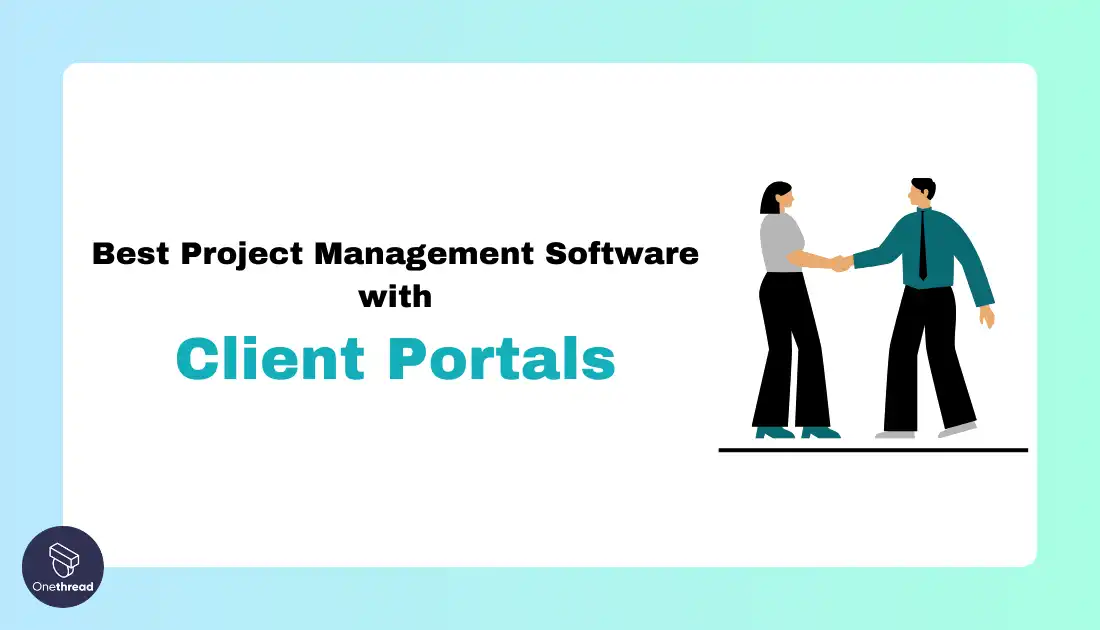Did you know that 82% of clients expect transparency and easy communication when working with businesses? Are you struggling to simultaneously keep projects on track while keeping clients continually looped in? Do costs or complexity stall aligning internal work with external transparency?
We compared the top 59 solutions and came up with the best 11 for you blending robust project management with seamless client portal capabilities so cross-functional teams can execute efficiently. Read on for the leading options we found to unite project orchestration with client visibility.
Quick List of 11 Project Management Software Client Portals
- Agency Handy: Best for creative agencies aligning teams and clients.
- Onethread: Best for consolidated client and vendor transparency.
- Monday.com: Best portfolio visibility linking strategy with work.
- ClickUp: Most adaptable work management ecosystem supporting some client views.
- Asana: Best lightweight workflow coordination for small teams.
- Smartsheet: Most flexible work execution platform allowing some customer visibility.
- Trello: Most intuitive project coordination with embeddable live board visibility.
- Wrike: Best customizable work management for complex initiatives.
- Basecamp: Best simplified project coordination for software teams.
- OneDesk: Best for customer ticket and delivery alignment.
- Zoho Projects: Best unlimited flexibility customizing project flow.
Now, let’s explain some key concepts you may need to understand before diving into the best PM software with client portals list.
Our reviewers evaluate software independently. Clicks may earn a commission, which supports testing. Learn how we stay transparent & our review methodology
What is Client Portal Software?
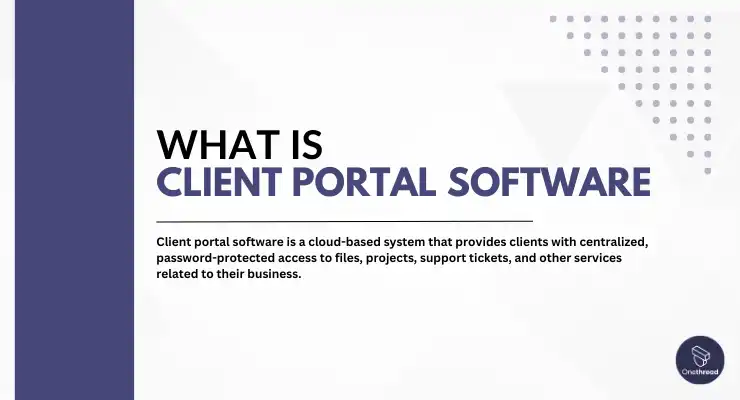
Client portal software is a cloud-based system that provides clients with centralized, password-protected access to files, projects, support tickets, and other services related to their business. The portals improve client communication, collaboration, and project management between a company and its customers.
In more detail, these client management systems help businesses to share documents, track and view project progress, submit requests, and more, all through a branded, online destination customized for each client. This eliminates paperwork and manual updates by centralizing operations and communication on both sides. Key features like permissions, file sharing, task management, and notifications make cross-company interactions seamless.
What is Project Management Software with a Client Portal?
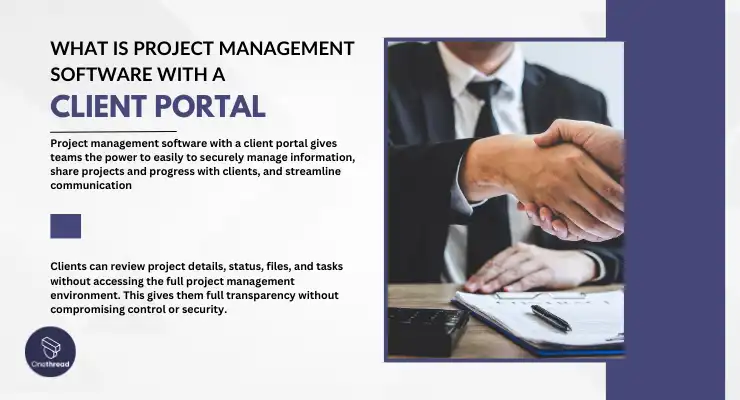
Project management software with a client portal is a combination of robust project collaboration features for internal teams with specialized portals for providing clients visibility. Clients can review project details, status, files, and tasks without accessing the full project management environment. This gives them full transparency without compromising control or security.
These specialized portals give clients access to project details, documents, schedules, progress, and more without allowing access to sensitive systems used by the delivery team.
In more detail, client portals act as an intermediate layer, securely connecting clients to project information without complexity or privacy risks.
Features like file sharing, milestone tracking, custom views, user permissions, notifications, and discussion channels facilitate transparency on project status and simplify cross-company communication. Portals ultimately foster better cross-functional collaboration through streamlined information sharing, approvals, feedback, and oversight.
Why Project Management Software Client Portals Are Important to Your Business?
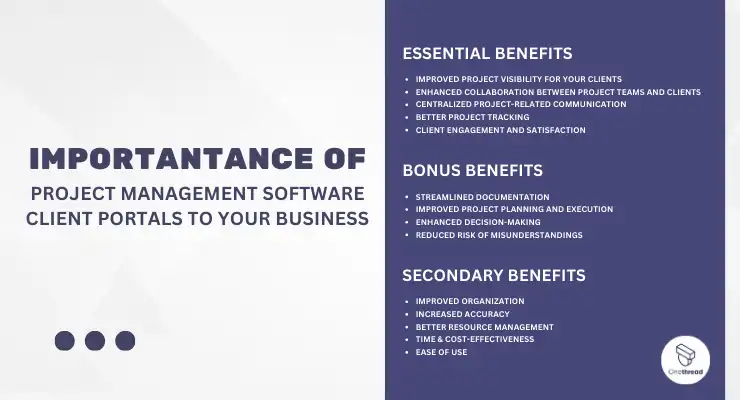
You need project management software with client portals for increased transparency, better collaboration, and an improved customer experience. Allowing clients centralized access to project specifics keeps them continuously updated to set accurate expectations, promptly answer questions, and build trust through engagement. This drives higher satisfaction scores, retention, and referrals.
Incorporating a client portal into your business operations can significantly enhance project management efficiency and foster stronger client relationships with numerous tangible and intangible benefits as follows:
Essential Benefits:
- Improved project visibility for your clients: Increased transparency and communication build trust and keep clients informed with real-time access to customizable project dashboards and reports.
- Enhanced collaboration between project teams and clients: Real-time communication and shared workspaces foster better teamwork and understanding by enabling seamless back-and-forth interactions.
- Centralized project-related communication: Eliminates email clutter and ensures all project information is accessible in one place through integrated activity streams, notifications, and discussion channels.
- Better project tracking: Streamlined task management, progress monitoring, and reporting improve project control and efficiency with tools to manage and analyze tasks, issues, risks, and dependencies.
- Client engagement and satisfaction: Increased involvement and access empower clients, leading to greater satisfaction and loyalty by humanizing interactions and promoting contribution.
Secondary Benefits:
- Improved Organization: A centralized platform reduces scattered information and improves overall project organization by storing all project assets, data, and conversations in a structured, easily searchable system.
- Increased Accuracy: Shared data and fewer communication channels minimize errors and inconsistencies thanks to a single source of truth and enhanced transparency.
- Better Resource Management: Visibility into team and client availability optimize resource allocation and utilization through calendars, utilization views, and demand reporting.
- Time & Cost-effectiveness: Reduced communication overhead, streamlined workflows, and improved project management can save time and money through process automation and optimized workflows.
- Ease of use: An intuitive client portal interface minimizes the learning curve and promotes user adoption with simple navigation designed specifically for external stakeholders.
Bonus Benefits:
- Streamlined documentation: Secure storage and access to project documents simplifies document management and retrieval through centralized, permission-based libraries.
- Improved project planning and execution: Shared goals and expectations within the client portal facilitate better planning and execution by enabling input gathering, approvals, and feedback loops.
- Enhanced decision-making: Real-time project data and insights empower informed decision-making for both teams and clients through interactive analytics and custom reporting.
- Reduced risk of misunderstandings: Clear communication and documented processes minimize misunderstandings and conflicts by connecting conversations to context within structured workflows.
Client portals humanize digital interactions for a relationship-focused, positive customer experience.
Features like real-time notifications, document previews, interactive dashboards, and contextual communication fuel convenience and understanding on both sides.
Customized views also promote value generation by allowing clients to reference assets specific to their needs – not just standardized reports. An exceptional portal experience cultivates confidence and loyalty.
Why Customer Experience Matters?
Customer experience matters because positive experiences lead to trust, engagement, loyalty, word-of-mouth referrals, and ultimately, higher lifetime value.
More specifically, customer experience encompasses every interaction a customer has with a business, across all touchpoints. When done right, through empathy, understanding, and human-centric design, exceptional customer experiences create emotional connections and relationships beyond one-time transactions. This drives customer retention, brand affinity, willingness to recommend, and profitable, long-term revenue growth.
Essentially, customer experience is a competitive advantage that sets industry leaders apart. Investing in and optimizing it must be a priority, not an afterthought.
Top 11 Project Management Software Client Portals
A reliable client portal in project management software is not just a tool; it’s a game changer. But with so many options on the market, which one stands out?
Software | Trial Info | Pricing | Key Features | Client Portal Features | Best For |
 | 14-day free trial | $49-$149/mo | Order Workflow, Task Delegation, Progress Tracking | Client Profiles, Centralized Communication | Small-Medium Agencies |
 | 30-day free trial + free plan | Free - $6/user/mo | Task Management, Custom Workflows, Integrations | Selective Data Access, Status Dashboards | Growing Teams |
 | 14-day free trial + free plan | $8-$16/seat/mo | Portfolio Analytics, Resource Management, Custom Views | Customer Dashboards, Notifications | Enterprise PM |
 | Free version | $7-$12/user/mo | Hierarchy, Integrations, Time Tracking | Access Rules, Interactive Reporting | Custom PM Needs |
 | Free version | $0-$25/user/mo | Goals, Team Collaboration, Custom Fields | Selective Data Access, Custom Client Views | Cross-functional Teams |
 | 14-day free trial + free plan | $9-$32/user/mo | Data Integrations, Automation, Dynamic Reporting | Discussion Streams, Forms | Professional Services |
 | Free version | $0-$10/user/mo | Boards/Cards, Power-Ups, Real-Time Updates | Card Updates, Calendar Views | Small Teams |
 | 14-day free trial | $10-$25/user/mo | Dashboards, Proofing, Custom Fields | Feedback Forms, Access Rules | Marketing Teams |
 | 30-day free trial | $15-$299/mo | Message Board, Automatic Check-Ins, To-Do Lists | Schedule Permissions, Selective Reporting | Small Teams |
 | 14-day free trial | $12-$19/user/mo | Unified Platform, Custom Forms, Task Automation | Real-Time Updates, Notifications | Startup Agencies |
 | 15-day free trial + free plan | Free - $12/user/mo | Gantt Charts, Automation, Custom Fields | Unified Profiles, Status Dashboards | Mid-Market Teams |
Let’s dive into the top eleven project management software client portals revolutionizing businesses’ operations. Join us on this journey to discover the best of the best.
1. Agency Handy
Unifies agency execution with client clarity
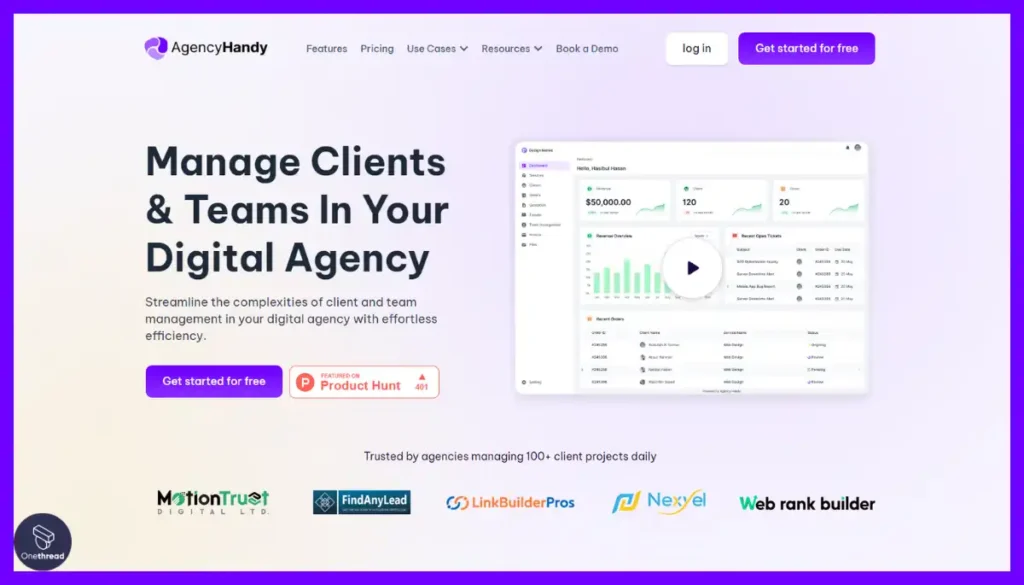
Agency Handy stands out as the premier platform tailored specifically for creative agencies to efficiently manage projects while streamlining client collaboration. During testing, Agency Handy impressed us with its centralized modules not just for structured project workflow between teams, but more critically also enabling transparency through client portals and simplifying stakeholder communications on updates.
What makes Agency Handy a standout leader is how thoughtfully it bridges connections between agency staff getting work done and clients constantly needing clarity on progress or issues arising. Features like integrated quotation building for project scoping combined with interactive portals keep aligned understanding that prevents frustrating delays down the line.
While versatile tools like Asana and Trello offer strong project foundations for internal teams, they lack built-in client portals for sharing external-facing views on workload or deliverables. Agency Handy balances project integrity with interactive client access through aligned modules and dashboards rather than fragmented stand-alone tools. For agencies specifically needing to showcase workflow progress, Agency Handy streamlines that connection to drive results and trust.
Features
Dive into features that bring clients closer to your projects, simplifying communication and streamlining delivery.
Customer Profiles & Onboarding
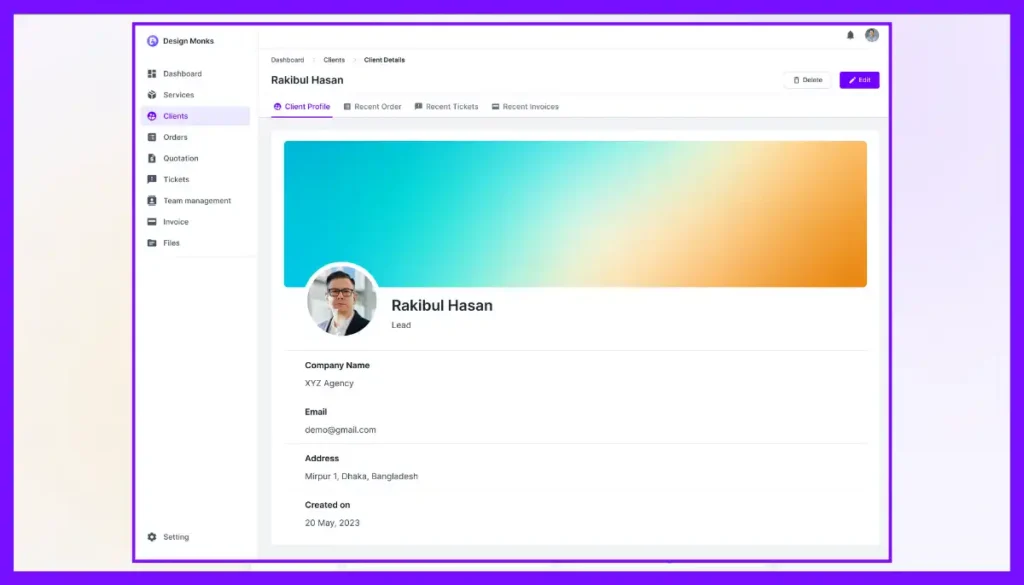
Centralizes all customers, contacts, specs, and comms history so all details are easily referenced in one dashboard avoiding the hassle of digging through fragmented silos to answer important questions.
Quote-to-Invoice Workflow
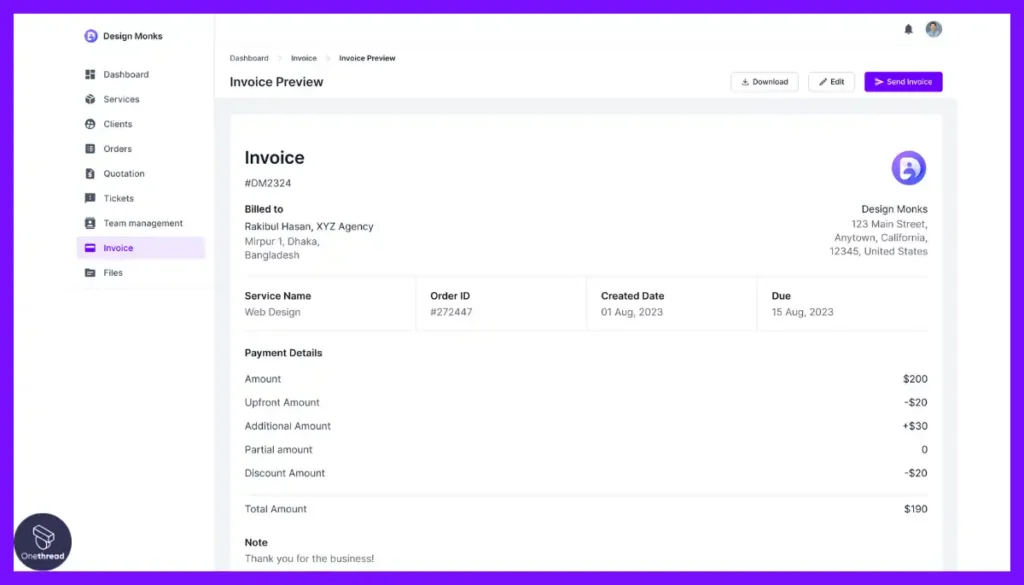
Enables creating and sending polished proposals, getting approvals, and tracking acceptance status while keeping everything connected to financials, work order details, and billing minimizing context-switching madness.
Milestone Roadmaps
Defines clear project plans with scheduled client checkpoints so teams execute purposefully instead of meandering through work reacting day-by-day without direction.
Unified Activity Stream
Shows real-time updates of messages, file uploads/updates, and discussions between clients and your team through one window sparing tedious game of email/phone/chat app tag.
Delegation & Access Rules
Designate permission-based access to sensitive data letting some cust. see relevant files/tasks/updates without exposing confidential information and internal activities maintaining trust.
Best Use Cases of Agency Handy
- Creative Design Agencies
Centralize visual project lifecycles while interactively reviewing creative concepts and assets with clients for transparency and reassurance.
- Digital Marketing Firms
Streamline campaign coordination across internal teams and client stakeholders with automated workflows for deliverables needing heavy collaboration.
- PR and Communications Teams
Structure the uncertainty of press relations efforts into agile sprints while reassuring clients with outreach efforts through real-time visibility.
- Video Production Companies
Visually map out complex video production workflows while using interactive views and approvals to complete quality control checkpoints.
- Consulting Services Boutiques
Shape fluid consulting engagements into structured roadmaps and isolate working documents so client privacy remains intact during collaboration.
Pros of Using Agency Handy as A PM Software with Client Portals
- Streamlines Project Scoping
Centralized proposals and quotation building align understanding between agency and customer right from project initiation.
- Structures Creative Workflows
Workflow modules, task boards, and roadmaps enable agencies to organize projects amidst the uncertainty creative endeavors bring.
- Improves Client Confidence
Interactive dashboards with project views and two-way conversations nurture trust and reassurance on work underway.
- Saves with Automation
Work templates, triggers, and custom rules activate repetitive tasks automatically to help teams focus on innovation.
- Encourages Internal Efficiency
Unified inboxes, delegated requests, and centralized files reduce redundancies for more effective resource allocation internally.
- Informs Executive Decisions
High-level and multi-project dashboards provide insights to identify resource gaps and keys to better sales estimates.
Pricing Plans
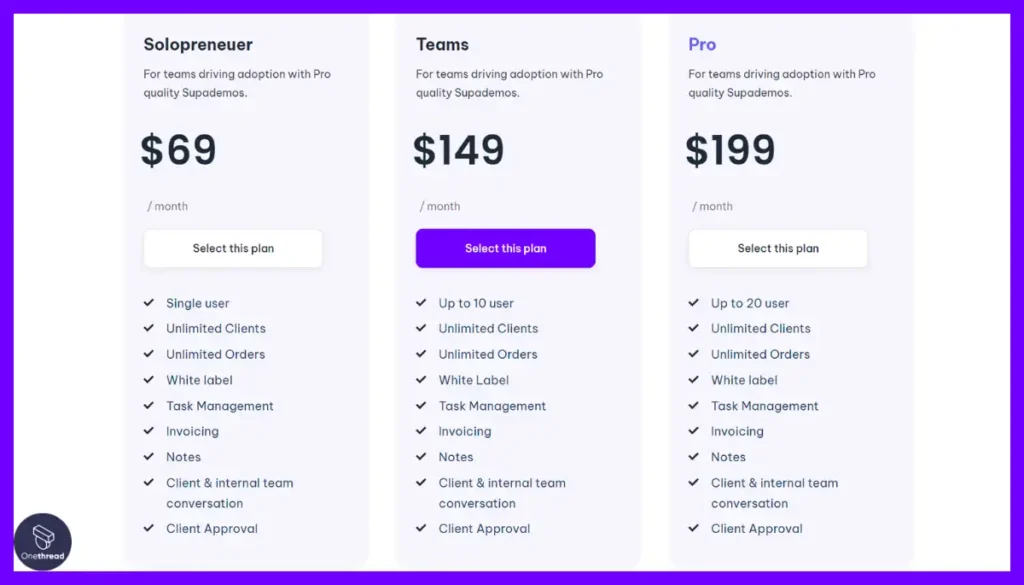
- Solopreneur – $49 per month (Billed Annually) | $69 per month (Billed Monthly)
- For single user
- Includes unlimited clients, orders
- Full project management features
- Teams – $99 per month (Billed Annually) | $149 per month (Billed Monthly)
- Up to 10 users
- Unlimited clients, orders
- Full project management features
- Pro – $149 per month (Billed Annually) | $199 per month (Billed Monthly)
- Up to 20 users
- Unlimited clients, orders
- Full project management features
What Users Say About Agency Handy?
Review on Product Hunt: 5 out of 5
“If you are handling multiple clients or agencies for your service, then try it out. One of the best solutions to manage everything in one place” – KH Sayed
Why Should You Choose Agency Handy?
Finding a project management solution with an integrated client portal can be challenging. Many options are either too complex for clients or lack critical business features. Agency Handy uniquely combines robust project management tools with an easy-to-use client portal to streamline collaboration.
Agency Handy Capabilities Matching User Needs:
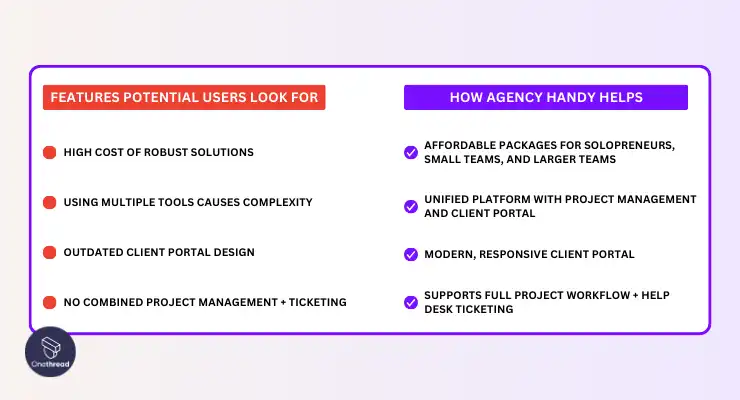
By consolidating project execution, communication, and client collaboration into one integrated platform, Agency Handy solves key pains users experience when managing initiatives across disparate tools. Packages fit all team sizes at reasonable prices. And with project management, task tracking, and help desk features unified with a modern client portal, Agency Handy brings welcome simplicity to coordinating client work.
2. Onethread
Consolidates distributed teams and vendors
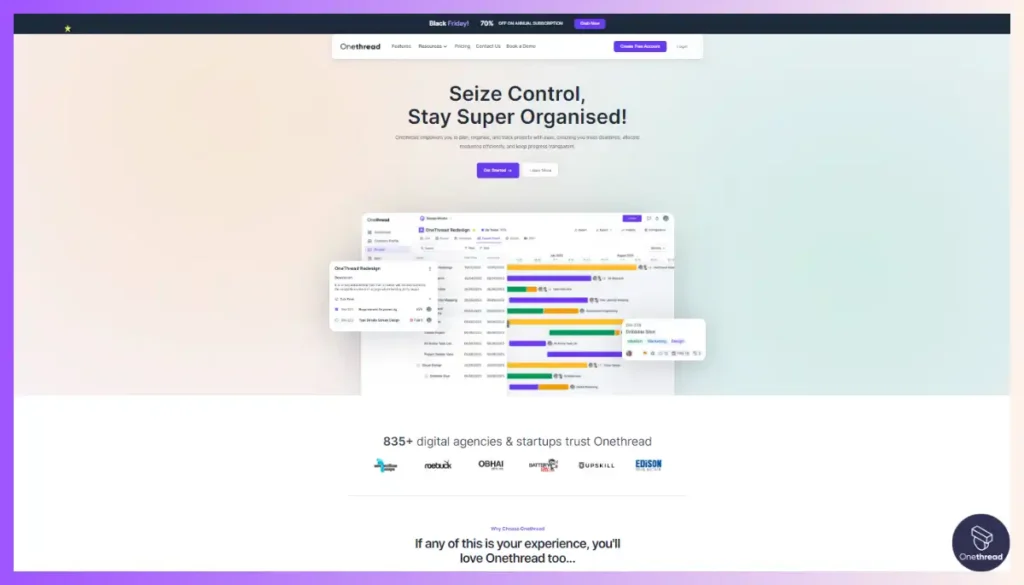
Onethread emerges as another compelling option for teams requiring an all-in-one project collaboration platform spanning internal task management with client-facing portals. OneThread stands out by directly connecting distributed stakeholders from staff to vendors to clients under one umbrella.
OneThread combines robust project management essentials for internal teams with uniquely integrated client portal capabilities to keep all contributors aligned. Testing showed OneThread simplifying coordination between critical project resources – staff task workflow, vendor dependencies, and customer transparency needs – all interconnected natively versus trying to duct tape separate tools.
While OneThread delivers core features like customizable Kanban boards, Gantt charts, timesheets, and reporting across teams like ClickUp, its vendor payment processing and client content reviewing capabilities tailored for service businesses stand out as differentiators. No need to toggle between other apps when managing capacity across internal assignments paired with external partner deliverables.
OneThread certainly lacks extensive breadth crossing chat, spreadsheets, and advanced customization boasted by ClickUp’s ever-widening array of gadgets. Yet for project managers needing to reduce toggling between windows to corral resources, validate deliverables, and reassure customers, OneThread consolidates the must-have pillars for operational coordination into one unified hub.
Features
Get a closer look at how Onethread’s unique approach to tasks and client involvement can elevate your teamwork.
Vendor Management
Consolidates contacts, preferences, history, and other client details in one easy-to-access hub to instantly pull up needed information instead of fumbling through disconnected spreadsheets when important questions arise.
Roles and Permissions
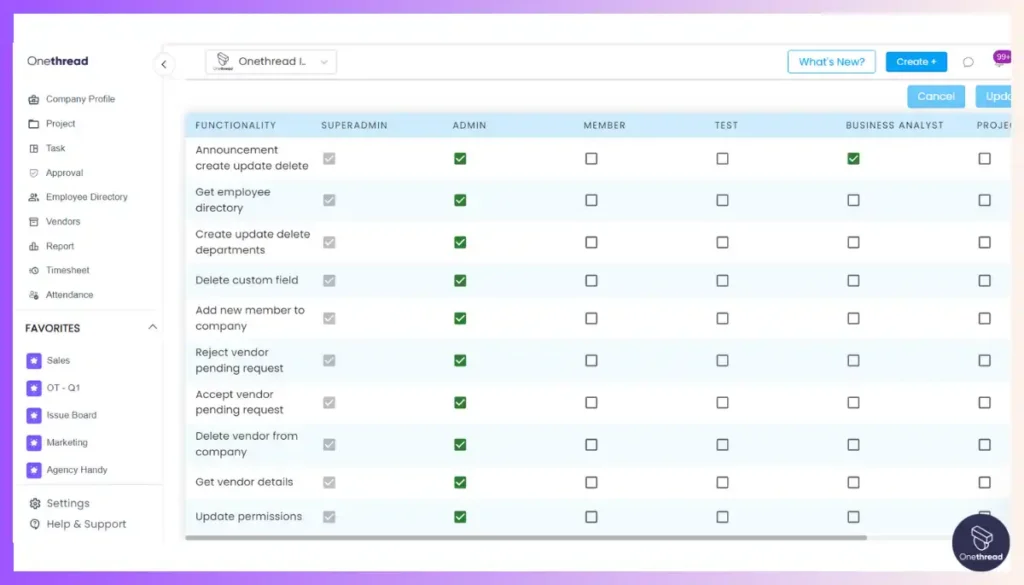
Enables defining granular permissions of precisely what clients can view or edit for each project protecting sensitive data while still collaborating transparently through integrated portals as needed.
Structured Issue Management
Logs problems with priority labeling, orderly status flow, and clear ownership so obstacles are resolved systematically not overlooked in a sea of fragmented email and chat threads stretching across multiple tools.
Real-Time Team Communication
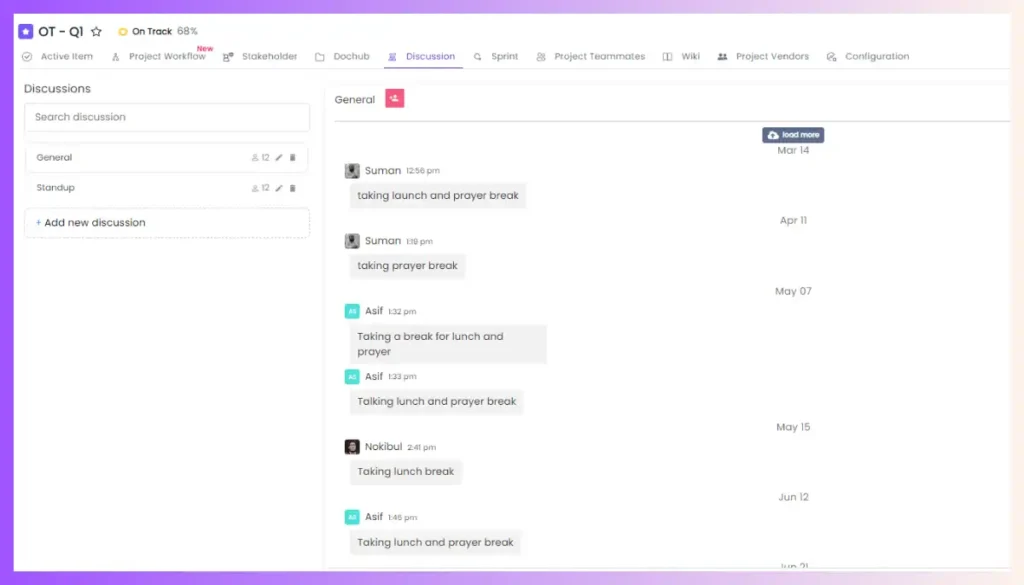
Features like instant messaging and chat let discussions happen transparently in the platform avoiding delays of email tags and keeping everyone continually looped in through a single conduit.
Customizable Task Management
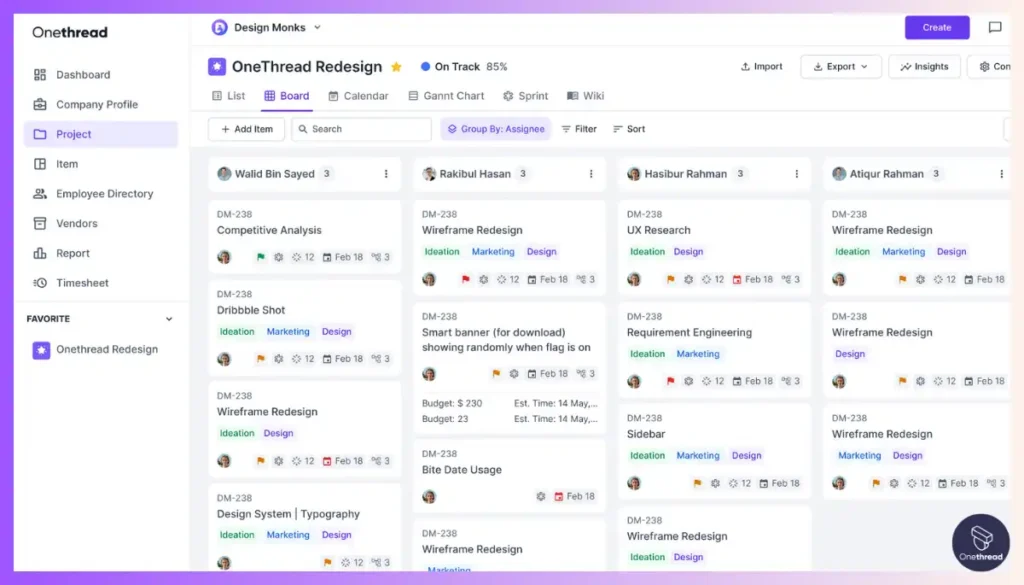
Tailor statuses, views, fields, and rules to match each project’s needs instead of wresting workflows to fit rigid templates speeding up how your team works.
Best Use Cases of Onethread
- Professional Services Firms
Consolidate client support ticket triage, solution delivery tracking, and portal visibility into one platform to strengthen service relationships.
- Distributed Team Coordination
Provide external partner teams and global divisional staff transparency into key milestones, assigning tasks across technology barriers.
- Project-Based Delivery Businesses
Standardized terminology, views, and workflows for complex client initiatives involving both internal assignments and external vendor dependencies.
- Regulated Industry Compliance
Incorporate validation checkpoints along with portal visibility to reassure customer confidence in quality standards for controlled projects.
- Remote Working Environments
Maintain clear priorities and sustained momentum with scrum dashboards, persistent chat, and uptime even when collaborating across locations.
Pros of Using Onethread as A PM Software with Client Portals
- Builds Client Trust
Allowing customers real-time visibility into progress, issues, and specifics manifests good faith efforts that nurture lasting relationships.
- Consolidates Essentials in One Place
Skipping the toggling between apps to update tasks, docs, and teams saves hours while preventing miscommunications that delay projects.
- Simplifies Cross-Team Coordination
Internal and external contributors remain linked in one environment to align, review, and drive projects forward without dropping balls.
- Structures Data and Decisions
Custom forms, tables, and reports bring order so you can find what matters across roles and filter noise to focus quickly.
- Clarifies Complex Initiatives
Gantt charts and workload management provide clarity, helping to identify unrealistic deadlines before they disrupt other teams.
- Empowers Real-Time Reactions
When inevitable questions or blockers emerge, persistent chat and comment threads enable collective course correcting to keep moving.
Pricing Plans

- Free Forever Plan – Free
- Unlimited organizations, projects
- 15 GB storage
- Growth Plan – $3 per user per month (Billed Annually) | $3.6 per user per month (Billed Monthly)
- Unlimited projects
- 100 GB storage
- Gantt charts
- Advanced reporting
- Scale Plan – $5 per user per month (Billed Annually) | $6 per user per month (Billed Monthly)
- Early access to new features
- Custom workflow, roles, permissions
What Users Say About Onethread?
Review on Product G2: 4.7 out of 5
“Onethread is super intuitive, easy to set up and transition into our everyday SOP. The platform is feature-rich without having a steep learning curve.
My favorite feature I’ve found so far is the ability to have multi-organization collaboration.
For the price, this is an awesome piece of kit!” – Finlay W.
Review on Product Hunt: 5 out of 5
“The onboarding process is much easier. It also helps me track my productivity. I am currently using the free trial. As far as I have used it, it has become a part of my life now. I love it. Thank you for the lovely tool. Best of luck.” – Anisul Islam
Why Should You Choose Onethread?
Finding an affordable project management solution with a user-friendly client portal can be a struggle. Solutions often cater only to technical experts or enterprises. Onethread simplifies work execution for businesses of any size with tools tailored for ease of use.
Onethread Capabilities Matching User Needs:
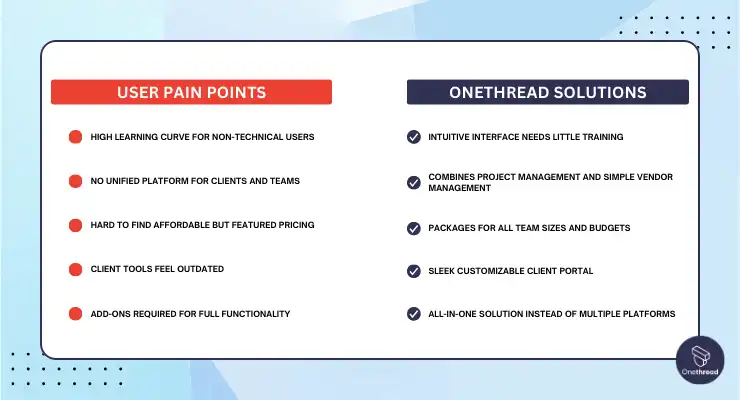
By bringing essential project management, communication, and client collaboration tools together in a straightforward interface, Onethread removes the adoption barriers smaller teams face.
Without technical complexity or hard-to-configure settings, clients can easily submit requests, track progress, and find answers in one place while internal teams execute smoothly. Onethread simplifies work coordination across clients and organizations affordably.
Try Onethread
Experience Onethread full potential, with all its features unlocked. Sign up now to start your 14-day free trial!
3. Monday.com
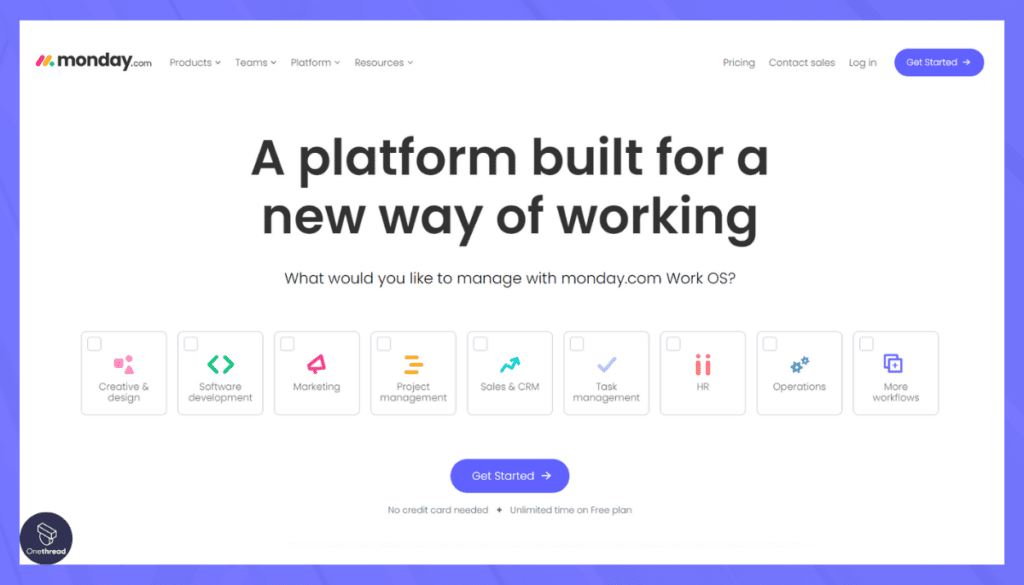
Strategic portfolio visibility into work
Monday.com clearly shines as a project portfolio management tool purpose-built to connect organizational objectives with client work execution. Firsthand testing revealed Monday’s uniqueness in providing end-to-end visibility bridging strategic goals, resource allocation, and portfolio progress transparency in one environment.
What makes Monday.com a standout is how thoughtfully it links lofty corporate plans with ground-level realities of getting work done. Features like goal setting, budget dashboards, and risk identification combined with project timeline tracking empower both C-suite and staff simultaneous clarity on what matters without dropping balls.
While versatile platforms like Asana offer reliable project foundations for internal teams, they lack built-in portfolio dashboards for executives to directly gauge progress-to-plan tradeoffs in strategy adjustments.
Read the detailed comparison between Monday and Asana for an in-depth understanding.
Monday.com leads where it counts in balancing project integrity with management transparency through aligned modules and visibility rather than siloed tools. For both project managers and executive leadership needing clear lines of sight linking vision with work, Monday.com paves that path to drive results.
Features
Explore how Monday.com’s powerful tools personalize your project management and empower seamless client interaction.
Customer Dashboards
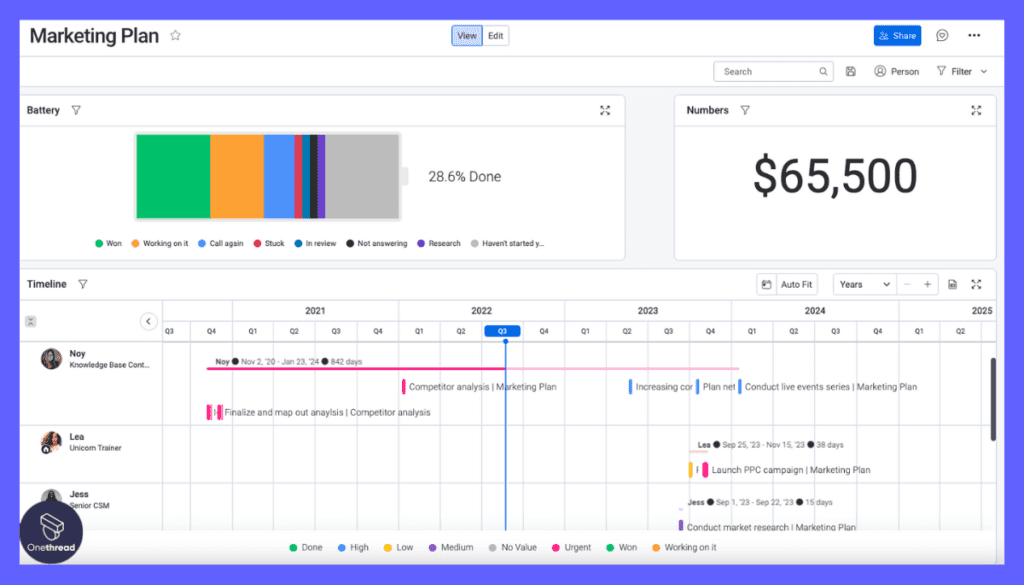
Centralizes customer profiles, contacts, history, and documents in one dashboard to easily reference details and answer questions without shuffling between systems.
Automated Workflow
Sets up sequences of status changes, assignments, approvals, and emails to move each deal predictably through quoting, ordering, and delivery reducing ad-hoc back & forth.
Real-Time Notifications
Sends instant updates to customers as changes occur without waiting for batch report emails so they can act on new developments right away.
Selective Data Access
Limits customer visibility to relevant project documents and timelines without exposing company financials or internal activities maintaining confidentiality.
Progress Analytics
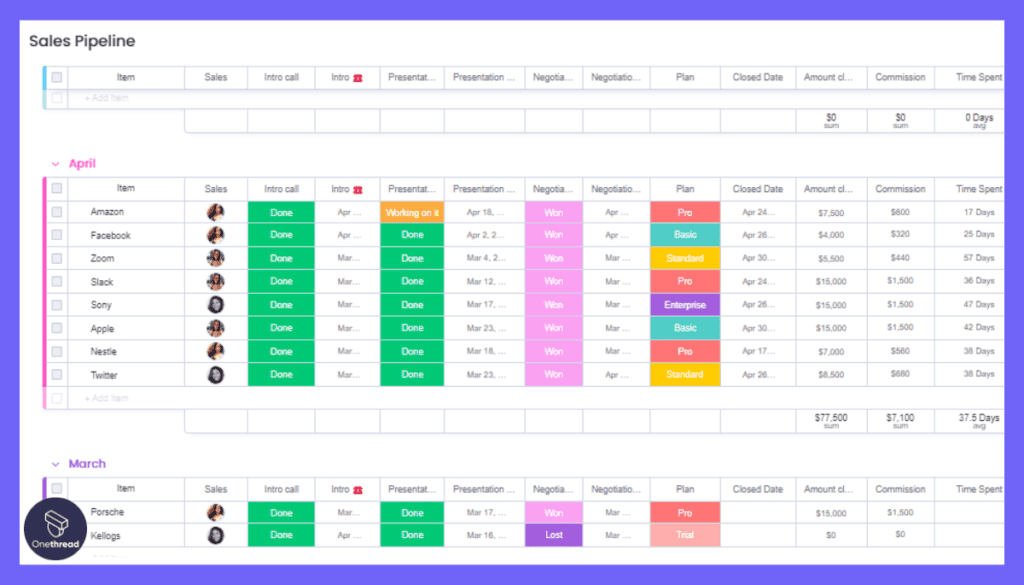
Enables customers to independently run reports on budget burn, milestones status, and blocker trends so they self-serve non-sensitive information.
Pros:
- Connects organizational goals with project outcomes
- Detailed portfolio-level visibility and insights
- Resource management assists with planning
- Range of timeline views to fit use cases
- Advanced security protocols offered
Cons:
- Steeper learning curve configuring automation
- Fragmented features without centralized workflows
- Mobile experience needs Smoothening
Pricing Plans:
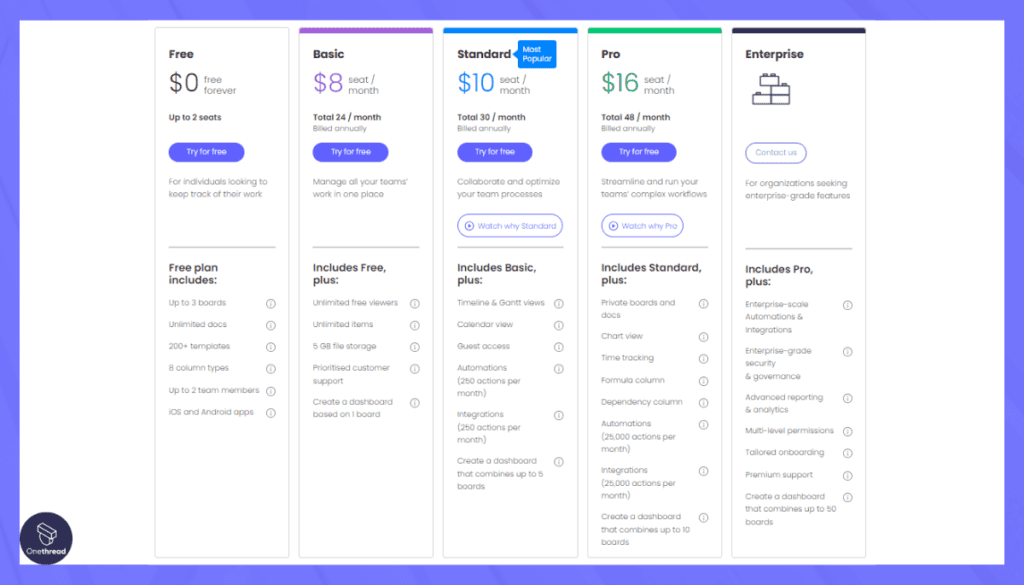
- Free – $0
- Basic – $8 per user/month
- Standard – $10 per user/month
- Pro – $16 per user/month
- Enterprise – Custom pricing
What Users Say About Monday.com?
Review on G2: 4.7 out of 5
“What do you like best about monday.com?
Monday lives of the tables that are formulated as task lists (enriched with details). It is very simple to set them up, view them as Kanbans, etc.
What really adds value on top are the automation and the good integrations with other platforms such as Slack, Gmail, SFDC, etc.
What do you dislike about monday.com?
I am not happy about how I can actually work on Monday. I am using other tools such as Google Docs or Notions to really keep my notes etc. This leads to me not using Monday for all projects as it is quite cumbersome to work in multiple tools.” – Verified User
4. ClickUp
Adaptable work management software
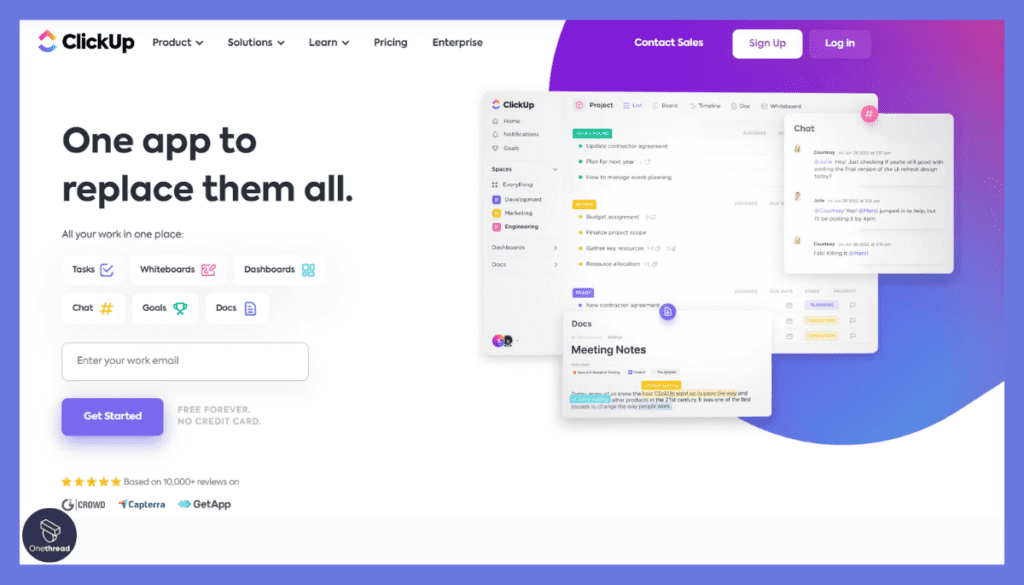
ClickUp emerges as a highly flexible project management platform for teams looking to manage internal work while providing external stakeholders visibility through client portals. During testing, we found that ClickUp equips project managers with versatile tools to visualize team progress while allowing customizable views to update clients accordingly based on permissions.
What ClickUp delivers through its Client Portal feature is the ability to shape fully transparent windows into relevant project details for outside partners and customers without compromising on internal tracking needs. Assigning granular access down to the list level allows managers to provide real-time progress visibility, approvals workflow, and document sharing without risking oversight of staff workflows.
Compared to purpose-built platforms like Agency Handy which consolidate project workflow with integrated client portals, ClickUp’s extensive customization does require added complexity in shaping and securing external access.
Yet for project teams wanting overarching workflow flexibility including client collaboration and visibility all under one umbrella, ClickUp provides one of the most versatile platforms available.
Features
Discover how ClickUp’s all-in-one platform tackles multiple aspects of project management, with client collaboration front and center.
Centralized Customer Hub
Consolidates profiles, history, and preferences in one dashboard to instantly reference details instead of piecing together information from various disconnected sources.
Custom Access Rules
Granularly configures permissions on what customers can view or edit in shared workspaces preserving confidential data while keeping them looped in.
Template Workflows
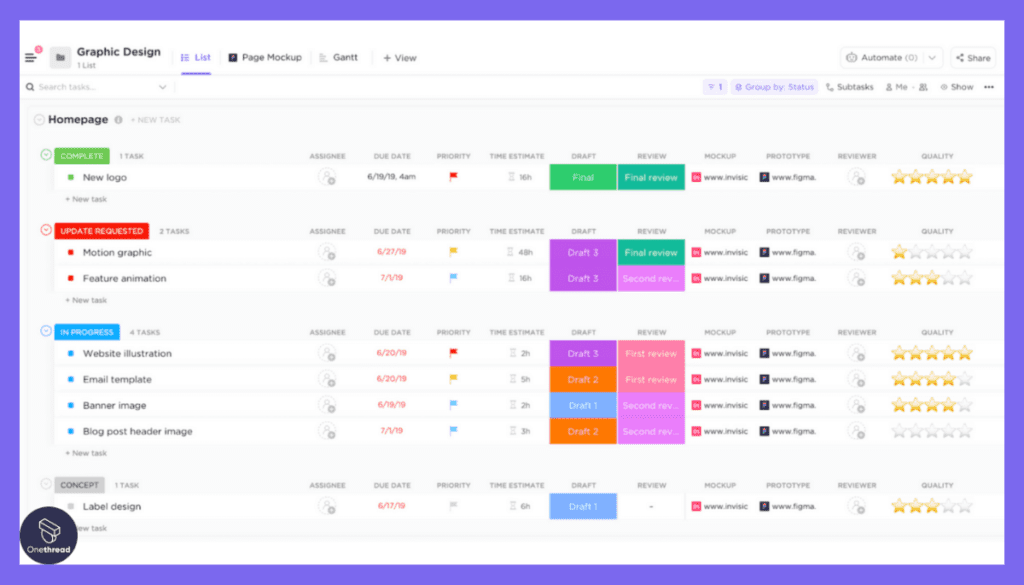
Defines sequenced steps for common customer order processes like submitting requests, quoting, and approving work so teams repeatedly execute efficiently.
Unified Message Threads
Allows communicating directly with customers within the platform avoiding delays of email/chat app back-and-forth keeping conversations transparent.
Interactive Status Dashboards
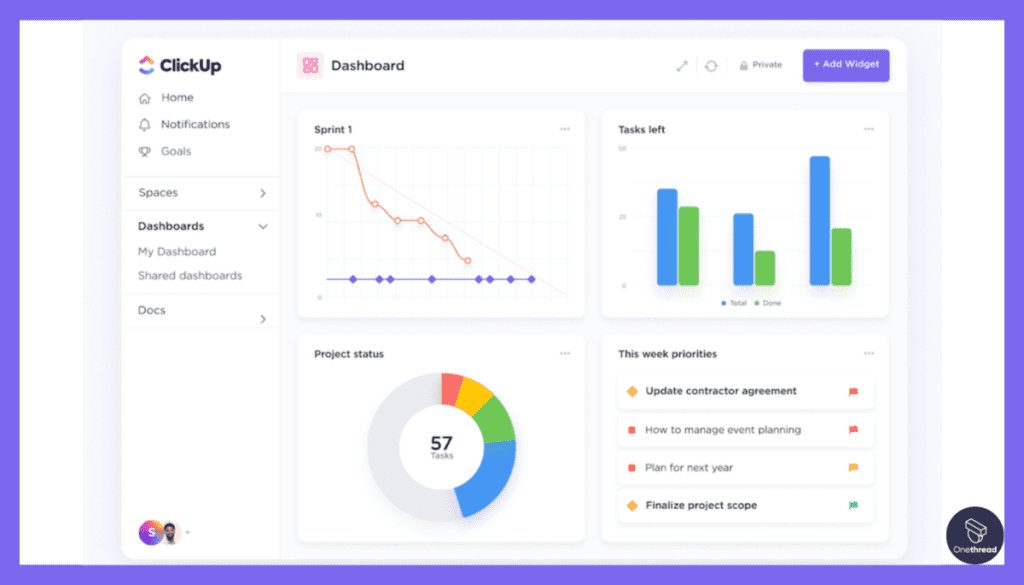
Enables customers to independently check in on budget, timeline, and blocker trends through real-time visual snapshots without having to chase down updates.
Pros:
- Highly customizable hierarchy and statuses
- Numerous project, task, and timeline views
- Extensive inherent and third-party integrations
- Comprehensive comment threads for collaboration
- Budget management capabilities
Cons:
- Complex with extensive options leading to confusion
- Custom fields can slow performance
- Reporting needs more interactive visuals
Pricing Plans:
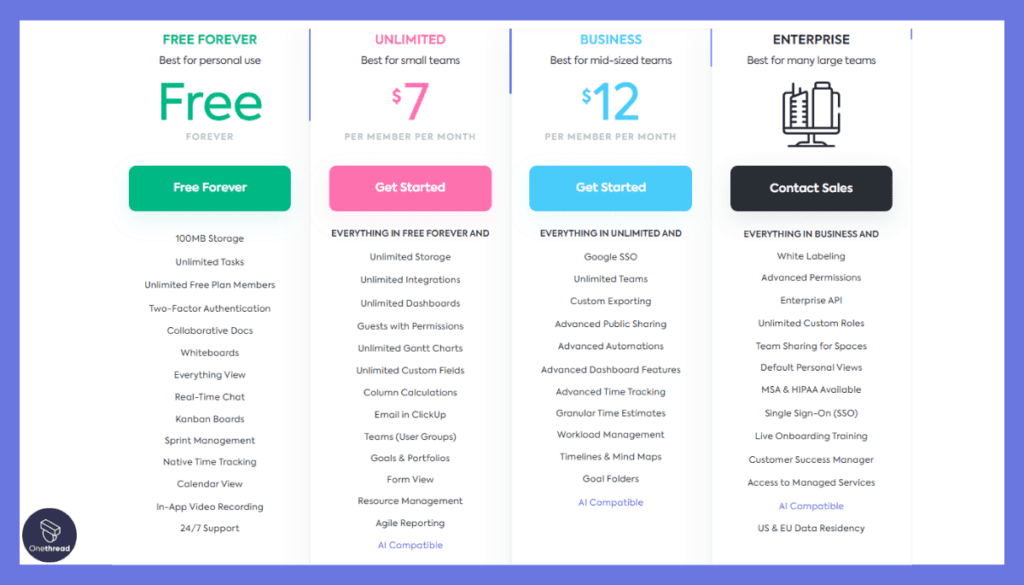
- Free Forever – $0
- Unlimited – $7 per user/month
- Business – $12 per user/month
- Enterprise – Custom pricing
What Users Say About ClickUp?
Review on G2: 4.7 out of 5
“What do you like best about ClickUp?
it’s a free tool used to interact with cross-location teams and also it allows the creation of different channels for collaboration purposes, it’s a tool that has some interesting features.
What do you dislike about ClickUp?
It’s not as friendly as expected, the channels joining requires an invitation or a specific link, also ClickUp needs to be more friendly in managing tasks, sub-tasks, and other data, the web version is slow, and needs to improve their performance and uptime” – Oscar D.
5. Asana
Simplified coordination for small teams
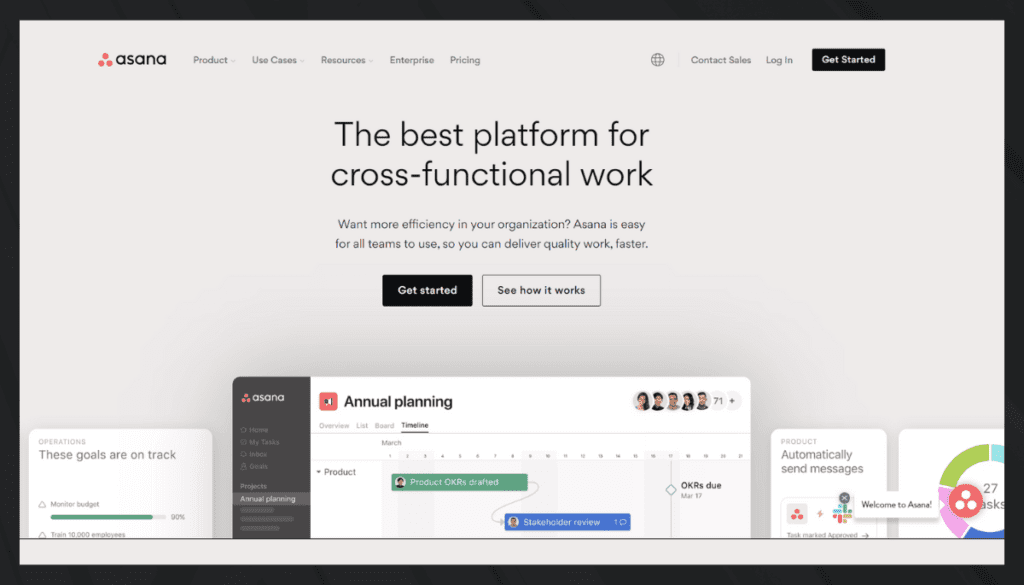
Asana is a project management platform built to help teams organize projects and tasks internally while still keeping external stakeholders looped in. During our testing, Asana’s simple and intuitive interface stood out for balancing collaboration features between team members with some capability to share read-only views outward to clients.
Where Asana falls short of more robust client portal functionality in tools like ClickUp is the level of customization in what portfolio details get shared externally. Asana’s simplicity that makes adoption easy does tradeoff granular control compared to ClickUp’s wider permissions customization and template options for client views.
However, for many small teams focused on internal workflow who only occasionally need to provide broader progress visibility to clients, Asana’s client portal gets the job done. Its elegant singular interface avoids the platform overload some users feel within ClickUp’s environment encompassing docs, spreadsheets, and everything under the sun.
Overall Asana sustains renowned user-friendliness with some external access flexibility while ClickUp certainly touts greater configurability but steeper learning curves for those client portal needs. Depending on the depth of external collaboration required, one platform may suit team needs better.
Read also: ClickUp vs Asana
Features
See how Asana’s clean approach to goal setting, collaboration, and selective client access boosts team productivity and client satisfaction.
Unified Client Profiles
Centralizes client contacts, documents, and prior history within their own unified profile making past context easily accessible.
Selective Data Access
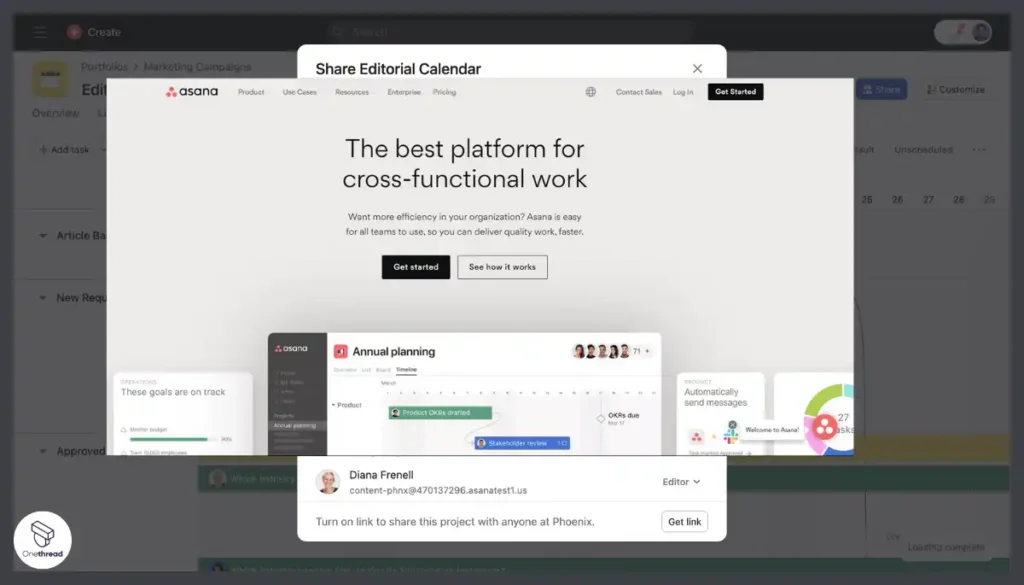
Defines granular access rules on what clients see in shared projects balancing transparency with data privacy across portals.
Custom Views for Clients
Enables configuring specialized calendars, boards, and tables filtered to each client’s needs for communicating relevant information clearly.
Automated Project Workflows
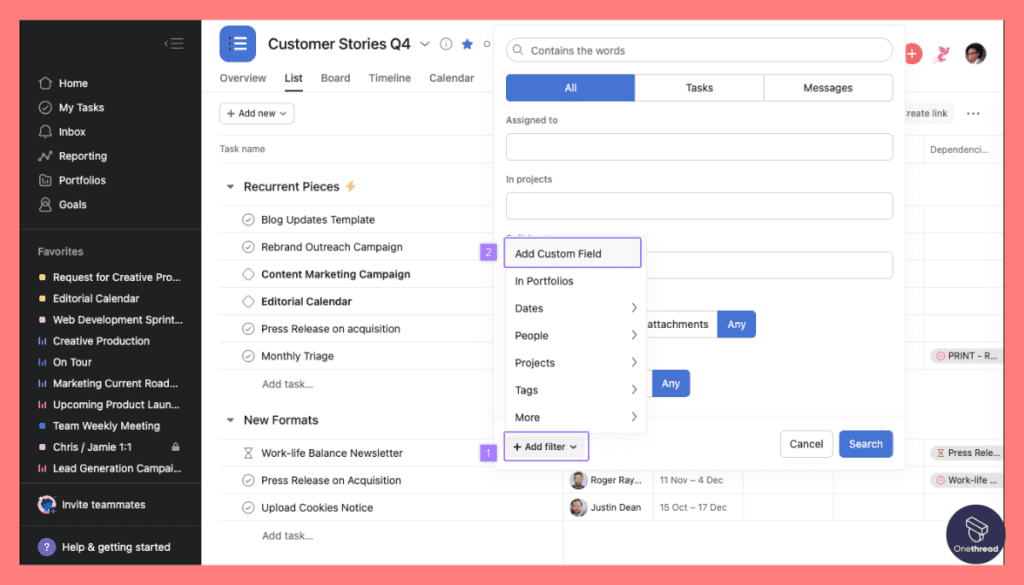
Sets up sequences of timed status changes, assignments, and reminders tailored to how each client likes to work.
Integrated Client Conversations
Allows communicating directly with clients in the platform instead of losing information across fragmented email threads and tools.
Pros:
- Shared projects hub to align cross-functional teams
- Custom rules and statuses match unique needs
- Goals hierarchy connects strategy with tasks
- Powerful filtering and board views
- Asana Intelligence provides project insights
Cons:
- Steep learning curve for automation
- Task dependencies need improvement
- Email update speed needs to increase
Pricing Plans:
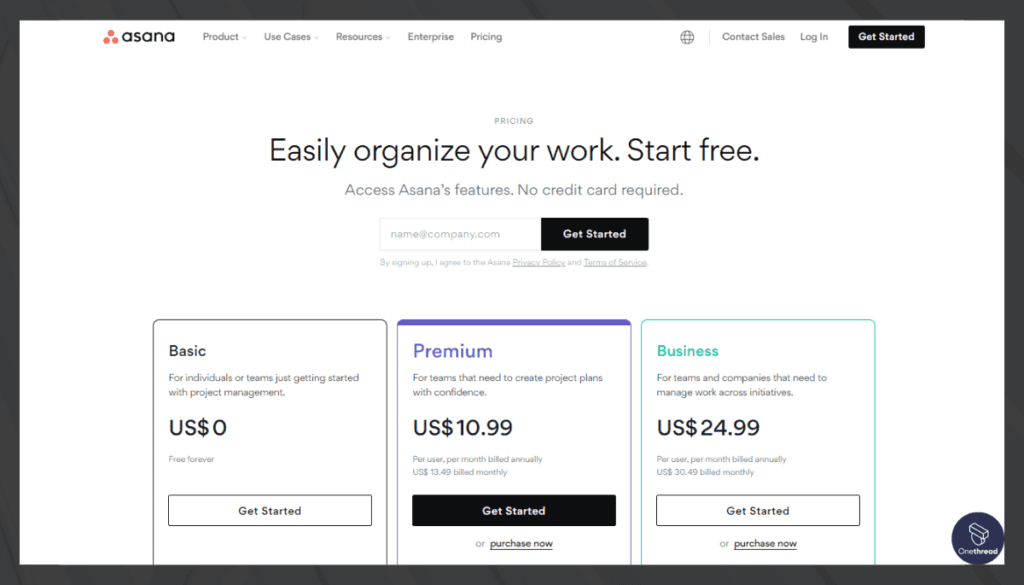
- Personal (Free) – $0
- Starter – $10.99 per user/month
- Advanced – $24.99 per user/month
- Enterprise – Custom pricing
What Users Say About Asana?
Review on G2: 4.3 out of 5
“What do you like best about Asana?
I like that you can collaborate on projects with different users. It’s easy to create new tasks and you can even create forms for people to submit. When you select a task as complete it has a great little animation that is almost celebratory.
What do you dislike about Asana?
Asana is a bit cluttered and can get overwhelming if you do not know how to use it. I do not like that you have to delete a task if you cannot complete it. Deferring a task also does not remove it from your list. Sometimes I do not want to delete a task, but I want to mark it as off my list even though it cannot be completed. That is extremely frustrating.” – Payton M.
6. Smartsheet
Customizable work management solution
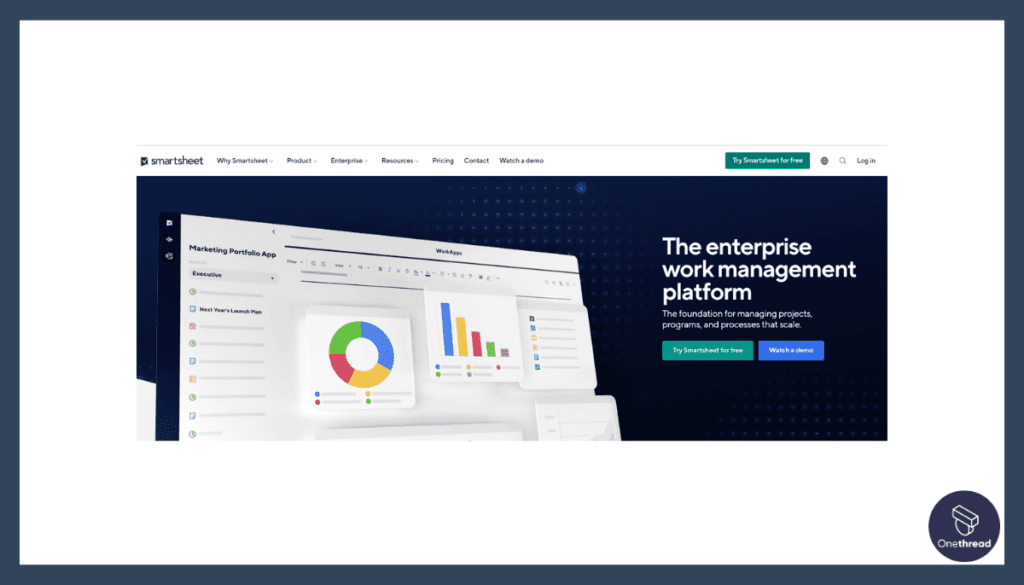
Smartsheet offers a flexible work execution platform catering to collaborative project needs across organizations with some ability to provide external visibility through its customer portal feature. During testing, Smartsheet’s intuitive interface for managing complex initiatives stood out while allowing certain insights to be selectively shared outward.
Where Smartsheet falls short of more complete client portal features compared to Monday.com is the level of pre-built templates, dashboards, and automated rules tailored for external visibility without heavy customization lift. Smartsheet’s broader focus across dynamic work execution shows in need to build up customized views and permissions suited for client access from its more generalized foundation.
However, for teams needing wider portfolio/program management capabilities along with occasional customer visibility beyond project management, Smartsheet balances functional breadth with selective external access compared to Monday’s more out-of-box client dashboard focus. Smartsheet sustains robust versatility with customizable client views while Monday.com prioritizes quicker standalone client adoption.
Features
Unleash data-driven insights with Smartsheet’s powerful features and interactive client dashboards.
Client Collaboration Hubs
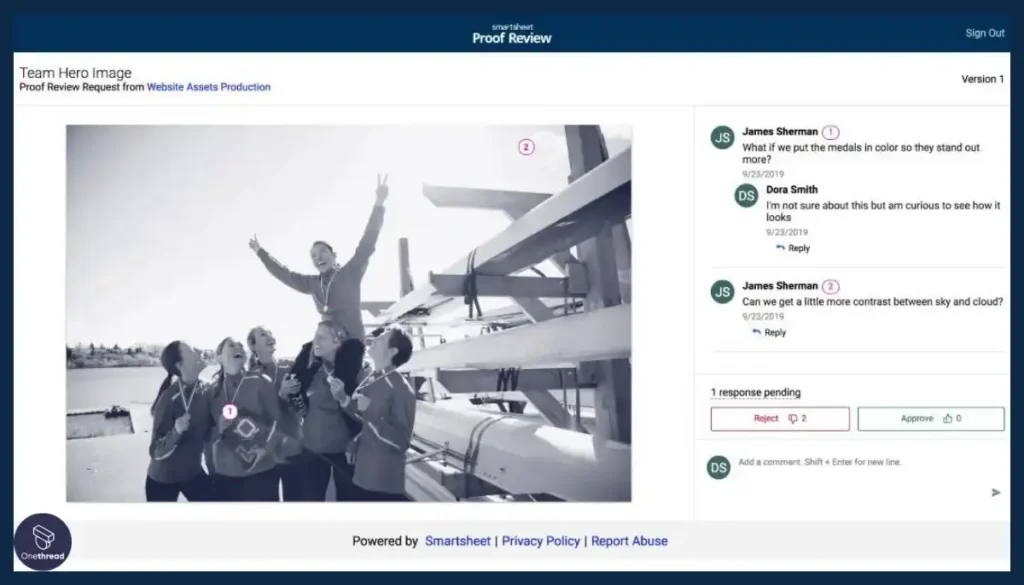
Designates spaces for clients to participate directly in discussions, document sharing, and task status checks through real-time activity streams.
Permissions by Client
Assigns graduated access levels by client balancing open collaboration with data privacy even when sharing to portals.
Dynamic Client Reporting
Enables configuring personalized reports on budget, milestones, and blockers for efficient self-service without manual report generation.
Client Feedback Forms
Creates structured data collection forms for gathering clients’ input centrally instead of through one-off surveys, emails, or chat tools.
Automated Client Workflows
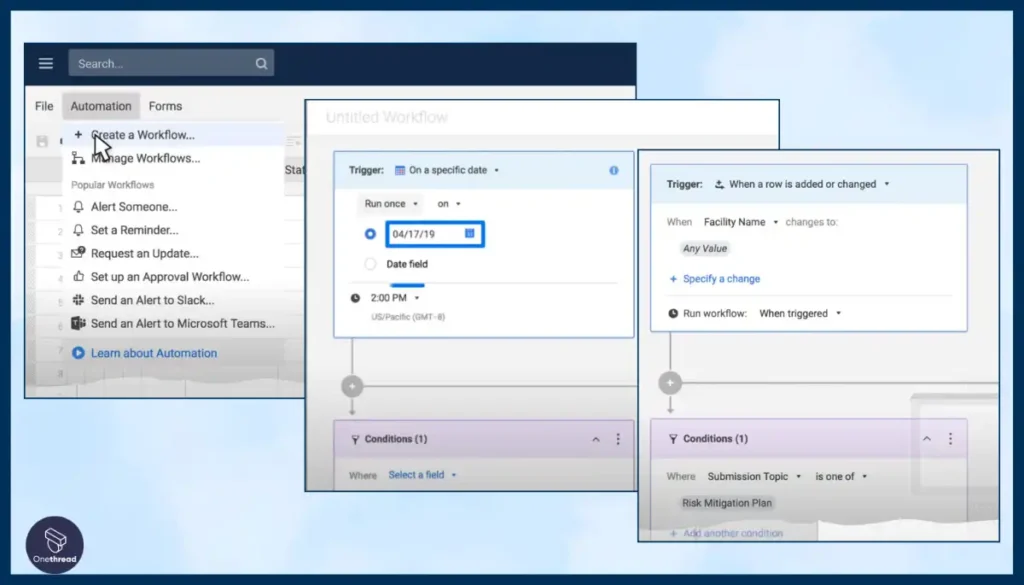
Sets up sequenced multi-step processes initiated automatically upon client actions like submitting help tickets, and signing off on deliverables.
Pros:
- Dynamic sheets provide flexible task management
- Custom objects tailor platform to business needs
- Extensive ecosystem of ecosystem integrations
- Control Center provides unified visibility
- Automated workflows increase standardization
Cons:
- Sheet performance can slow at high complexity
- Steep initial learning curve
- Formulas can be time-intensive
Pricing Plans:
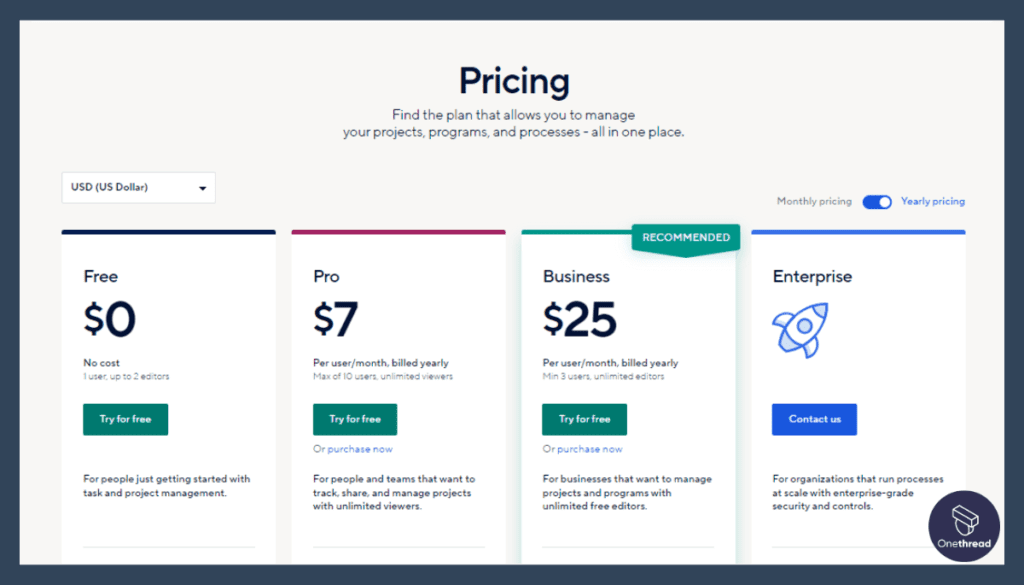
- Free – $0
- Pro – $7 per user/month (annual billing), $9 per user/month (monthly billing)
- Business – $25 per user/month (annual billing), $32 per user/month (monthly billing)
- Enterprise – Custom pricing
What Users Say About Smartsheet?
Review on G2: 4.4 out of 5
“What do you like best about Smartsheet?
It works very well with Excel. Simple copy and paste. I also like being able to attach files to rows. Customers seem to like being able to view it online also.
What do you dislike about Smartsheet?
Smartsheet is nice but it needs to be more automated. It takes too long to manually update the smartsheets. It would be better if you could open a smartsheet, click a button and it could pull in information from an Excel or PDF file.” – Chris C.
7. Trello
Flexible Kanban boards with visibility
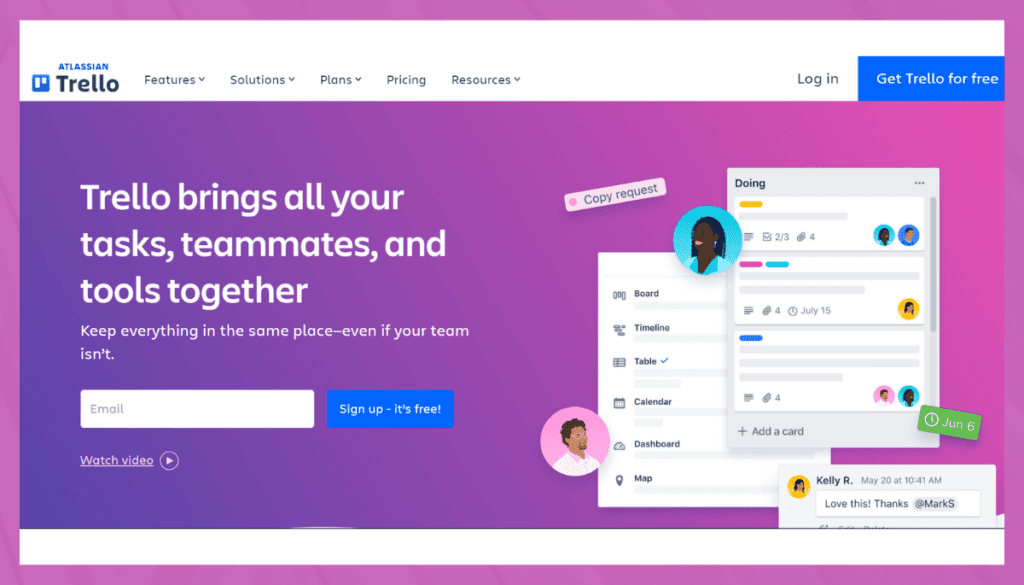
Trello shines as a flexible, visual project management solution built around agile Kanban boards suited for many team workflow needs. Testing showed Trello simplifies the coordination of tasks and projects with intuitive drag-and-drop cards for organizing work and collaborating.
Trello offers versatile features like calendar views, dashboard overviews, and project templates allowing managers to visualize workflows that work best. Granular control over cards and boards provides adaptable building blocks.
While Trello caters more to agile frameworks, Asana is better suited for traditional linear waterfall projects given its list formatting and augmented features like milestones and Gantt charts. Yet Trello sustains flagship status for lightweight, visual workflows on the go compared to Asana’s dual mobile and desktop strengths.
Overall Trello delivers easy adoption and transparency for Kanban teams. The ability to embed live boards provides some high-level visibility functionality missing robust client portals. For agile teams and simple external access needs, Trello excels in flexibility and clarity.
Features
Get organized and keep teams on track with Trello’s visual boards and real-time client updates.
Centralized Client Profiles
Consolidates client contacts, preferences, and history in unified dashboard profiles for convenient reference avoiding fragmentation.
Selective Board Access
Invites specific clients to designated boards with granular permissions to balance transparency and privacy.
Real-Time Card Updates
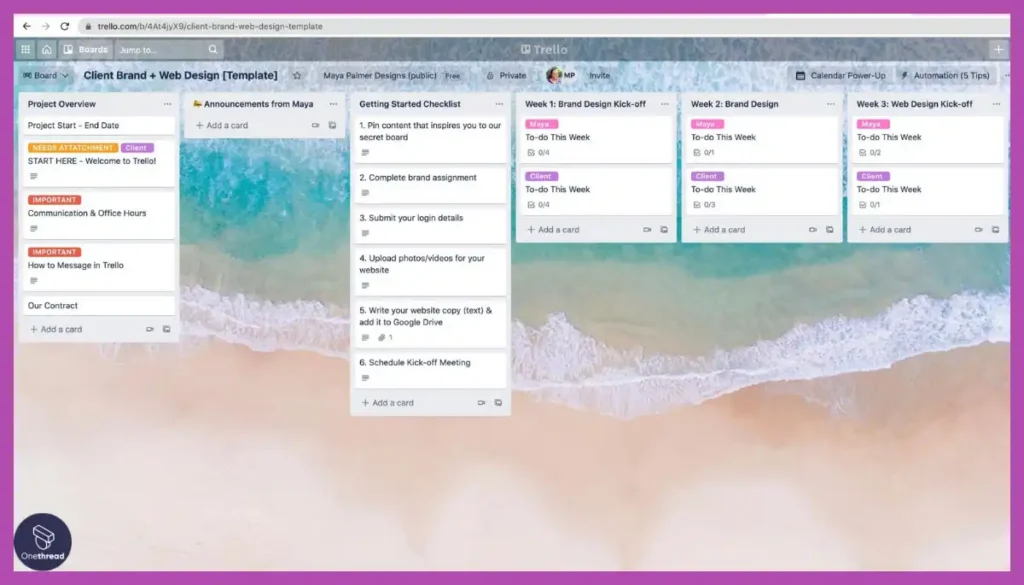
Enables clients to independently track task progress through card movements and conversations without having to ask for updates.
Custom Client Views
Configures specialized table, calendar, and dashboard views filtered to each client’s specific interests for communicating relevant information.
Automated Notifications
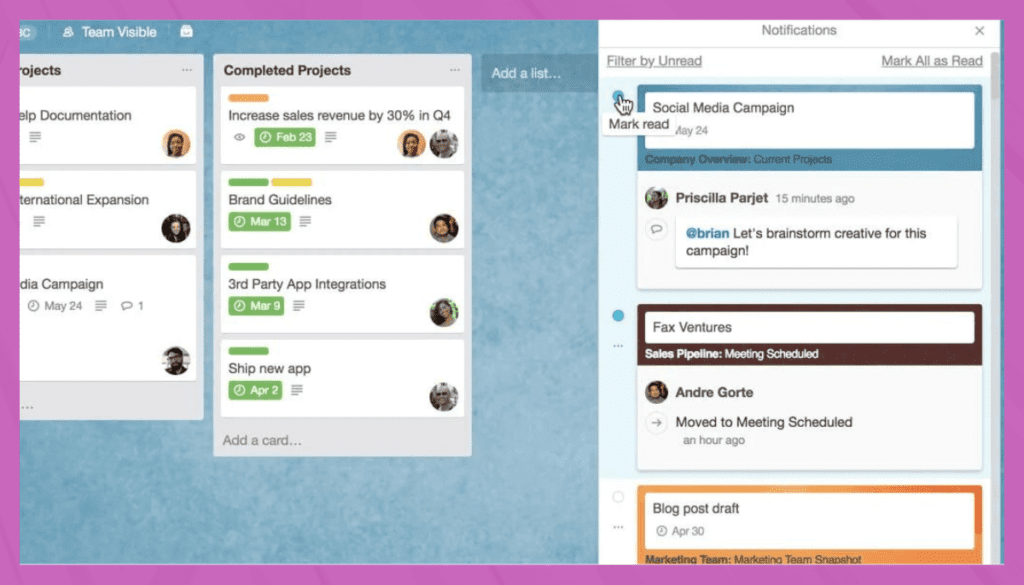
Sets up instant email or in-platform alerts to notify clients when key events occur like due date changes, task approvals, and blocking progress.
Pros:
- Intuitive boards/cards eliminate learning curve
- Granular card customization enables flexibility
- Numerous Power-Ups integrate useful tools
- Updates visible in real-time across shares
- Simple pricing avoids user fees
Cons:
- Reporting/analytics needs improvement
- Tracking dependencies needs smoothening
- Rule triggers can underdeliver
Pricing Plans:
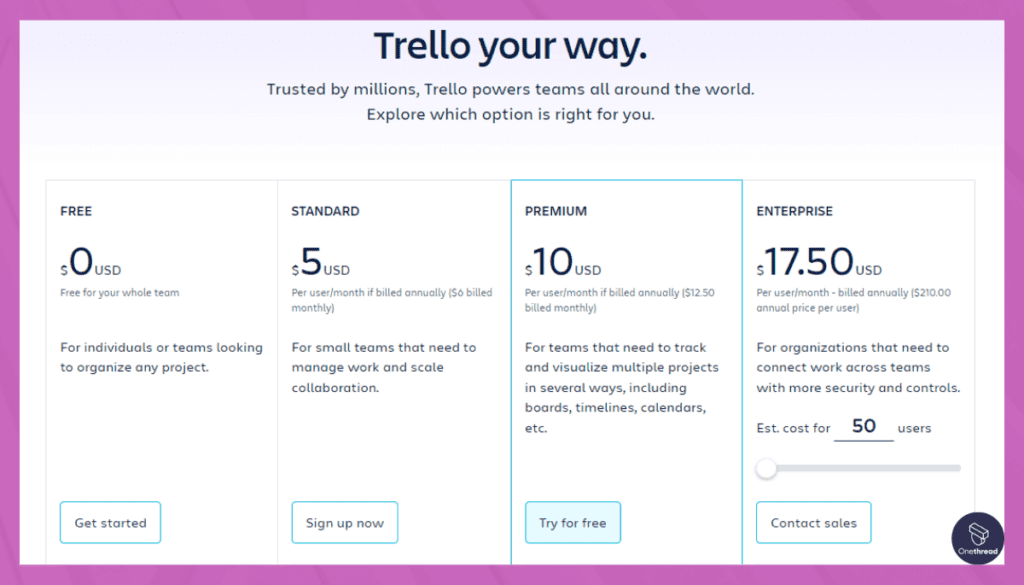
- Free – $0
- Standard – $5 per user/month (annual billing), $6 per user/month (monthly billing)
- Premium – $10 per user/month (annual billing), $12.50 per user/month (monthly billing)
- Enterprise – $17.50 per user/month (annual billing)
What Users Say About Trello?
Review on G2: 4.4 out of 5
“What do you like best about Trello?
Trello was a go-to at a prior company – it was how we managed our daily/weekly projects and broke the work down into smaller, manageable tasks. I loved that Atlassian acquired Trello.
What do you dislike about Trello?
Now fully on board with Atlassian products like Confluence and Jira, Trello can be used but isn’t necessarily the best option when most of the company uses Jira. It is ideal for personal work management and tracking, though.” – Dave B.
8. Wrike
Customizable work management platform
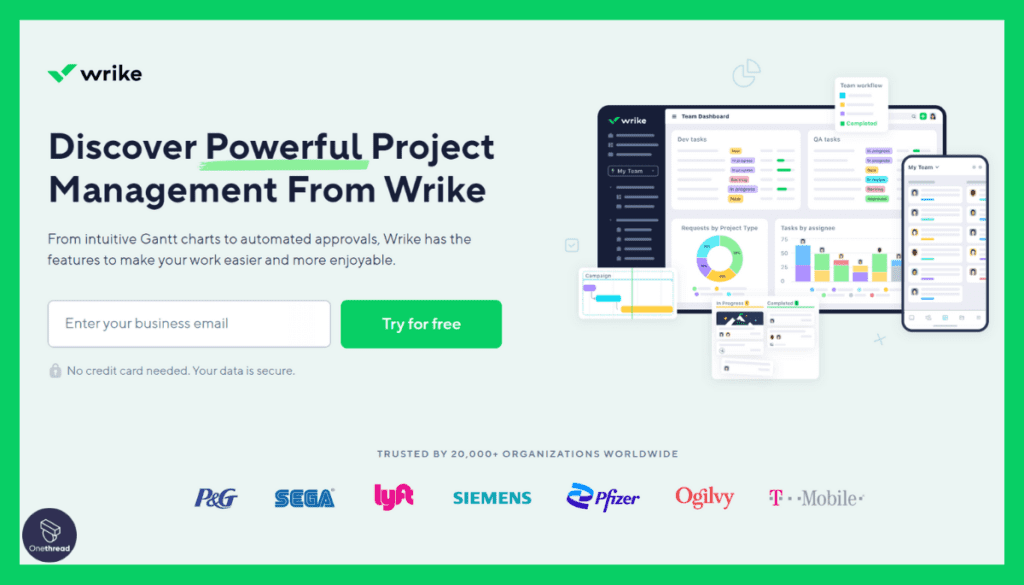
Wrike emerges as a versatile work management platform equipped to handle complex project needs across organizations with some ability to provide external visibility through its external collaborator feature. Testing showed Wrike balancing robust task hierarchy, customizable fields, and views with simple workflow automation.
Wrike enables teams to tailor the platform to their planning approach whether agile boards, grid schedules, or Gantt charts. Features like proofing, analytics, and resource allocation tracking provide multilayered functionality alongside some customer portal access.
Where Wrike falls short on client portal capabilities compared to a platform like Monday.com is the tailored executive dashboards ready for stakeholder visibility. Wrike’s broader task-based focus shows it needs heavier configuration for its more generalized foundation to achieve the same clean external visibility as Monday’s dedicated portfolio views.
Yet for complex initiatives with occasional customer visibility needs supplemented by other channels, Wrike strikes excellent versatility between management and collaboration. Its wider feature set can suit more use cases than Monday’s more singular portfolio focus.
Features
See how Wrike’s intuitive task management, proofing tools, and customizable client access can take your marketing projects to the next level.
External User Collaboration
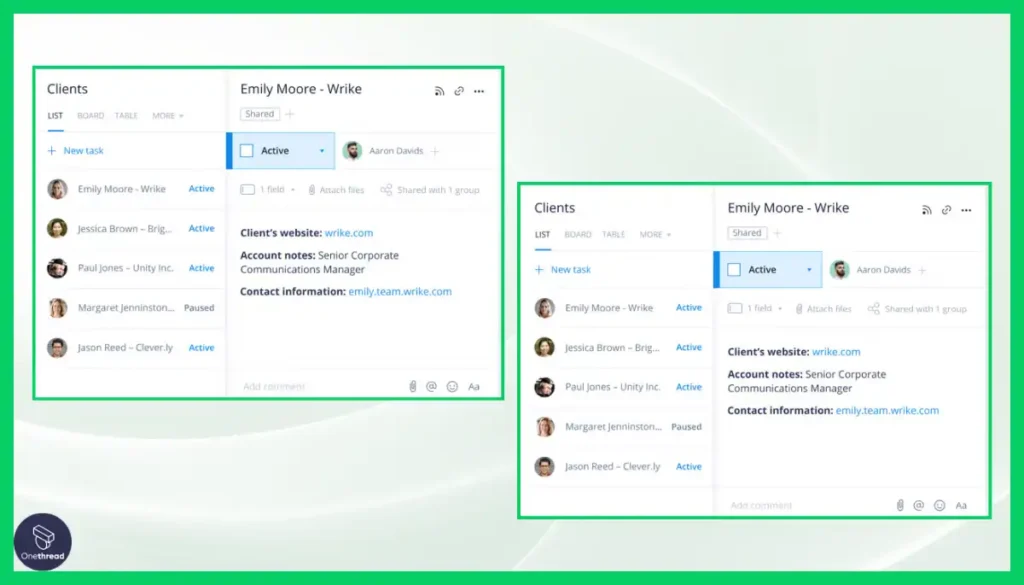
Designates shared folders for clients consolidating task tracking, file sharing, discussions, and reporting in one hub.
User Roles and Permissions
Defines granular visibility rules on what clients can view or edit in their workspace balancing open collaboration and privacy.
Structured Client Feedback
Creates centralized forms and schedules automated prompts for capturing client input instead of passive email surveys and chat tools.
Custom Client Dashboards
Configures specialized real-time dashboards on budget, milestones, and risks tailored to each client’s specific interests.
Email Notifications
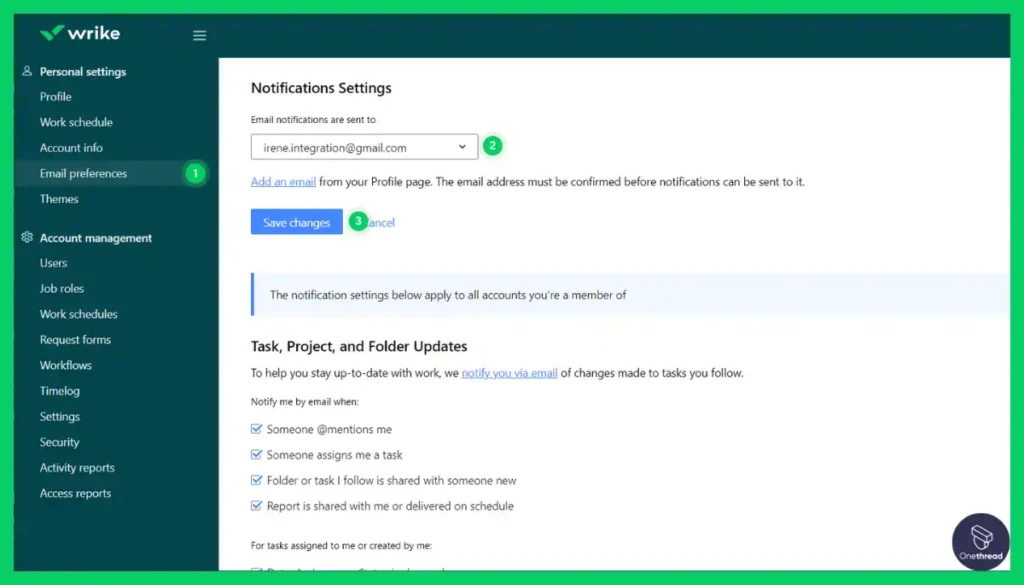
Sets up instant email notifications when workflow milestones are completed or critical path delays occur keeping clients informed without asking.
Pros:
- Streamlined work structuring with folders/tasks
- Interactive dashboards provide visibility
- Custom statuses aid flexibility needs
- Rigorous access control protection
- Extensive integration platform
Cons:
- Mobile functionality needs smoothening
- Steep learning curve initially
- Reporting lacks dynamic filtering
Pricing Plans:
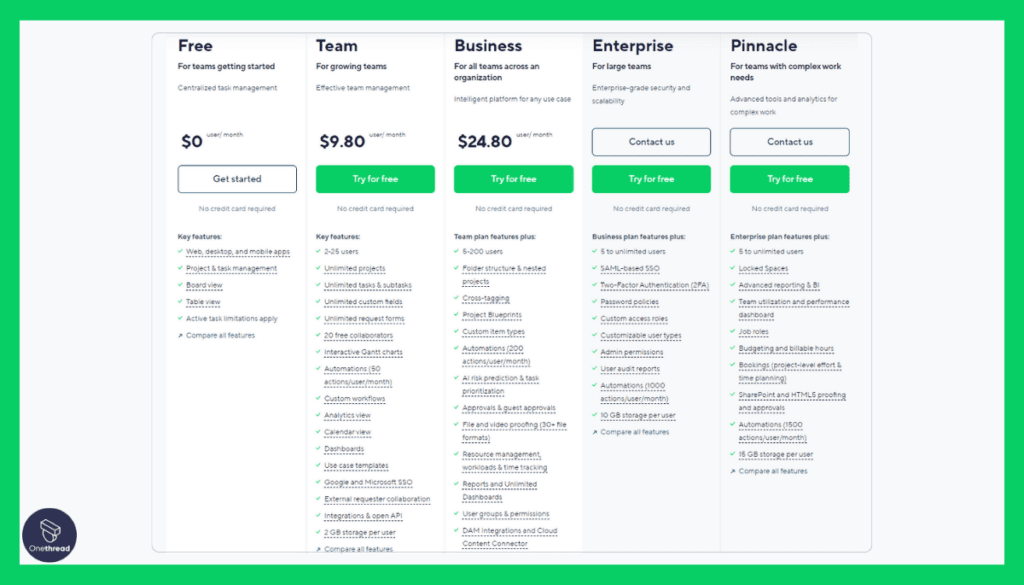
- Free – $0 per user
- Team – $9.80 per user/month
- Business – $24.80 per user/month
- Enterprise – Custom pricing
- Pinnacle – Custom pricing
What Users Say About Wrike?
Review on G2: 4.2 out of 5
“What do you like best about Wrike?
Great way to stay organized and keep all of our project information in one place. Once people get used to it, they are able to store content, communicate, and share items all in one place.
What do you dislike about Wrike?
Doesn’t fully replace everything we were using our Google Drive for in terms of managing projects. Also, there is a big learning curve to get used to it which is daunting to some employees. I wish they provided more support to customize our configuration!” – Verified User
9. Basecamp
Streamlined software team coordination
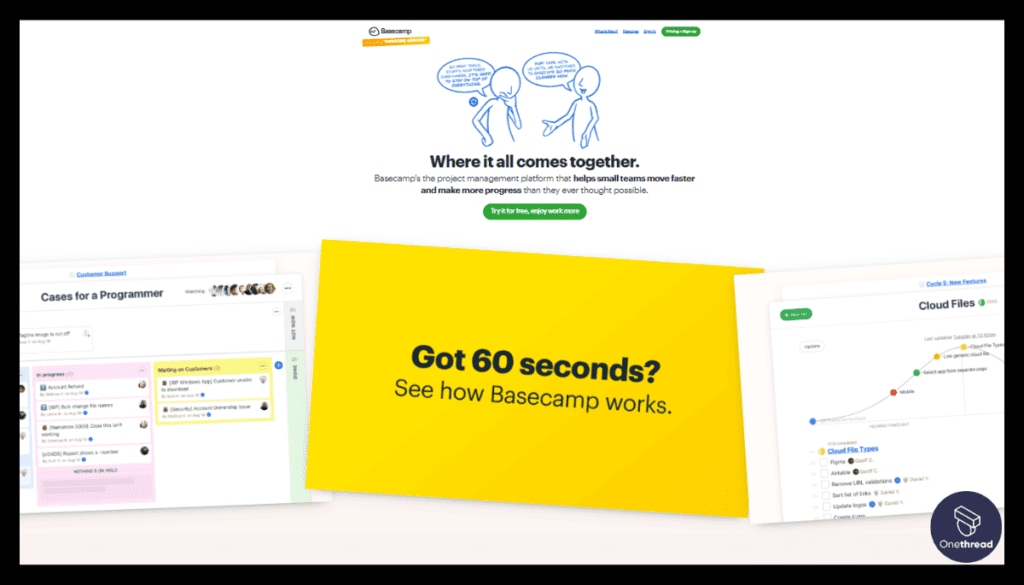
Basecamp stands as a longstanding pillar in the project management space, bringing simplicity and ease of use specifically for software teams collaborating. Offering a central dashboard, Basecamp condenses key information streams into unified channels around messages, tasks, docs, schedules, and check-ins.
Our testing found Basecamp avoids feature overload common in platforms like Asana, instead providing a curated set of essentials for product teams to coordinate work. Integrations expand capabilities while the unique Hey! feed aggregates notifications into a single easy-access hub.
While Asana excels in flexibility to mold more diverse team workflows beyond software dev, Basecamp Zone focuses on delivering specialized fabric-welcoming software groups. For product teams wanting lightweight PM avoidance of intricate configuration, Basecamp says “Come as you are”.
In summary, Basecamp sustains specialty effectiveness for software development teams valuing simplicity alongside purpose-built collaboration tools. For software groups, this pioneering platform feels like home.
Features
Explore how Basecamp’s message boards, automatic check-ins, and simple client access keep small teams aligned and on the same page.
Consolidated Client Profiles
Centralizes key client contacts, history, and preferences in one place for easy access without fragmentation into various systems.
Message Board Access
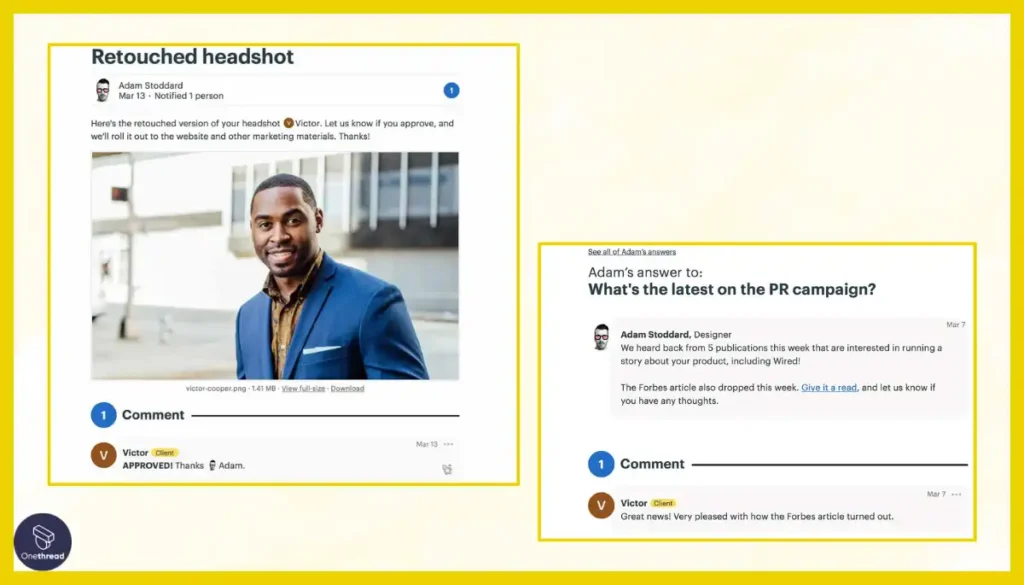
Enables selectively allowing customers onto project Message Boards to participate in discussions and get real-time updates.
Schedule Permissions
Defines granular event, milestone, and task visibility rules per client balancing transparency with privacy.
Automatic Check-In Requests
Prompts clients to provide feedback on progress, and blockers need on a set customizable schedule centralizing input.
Selective Reporting Access
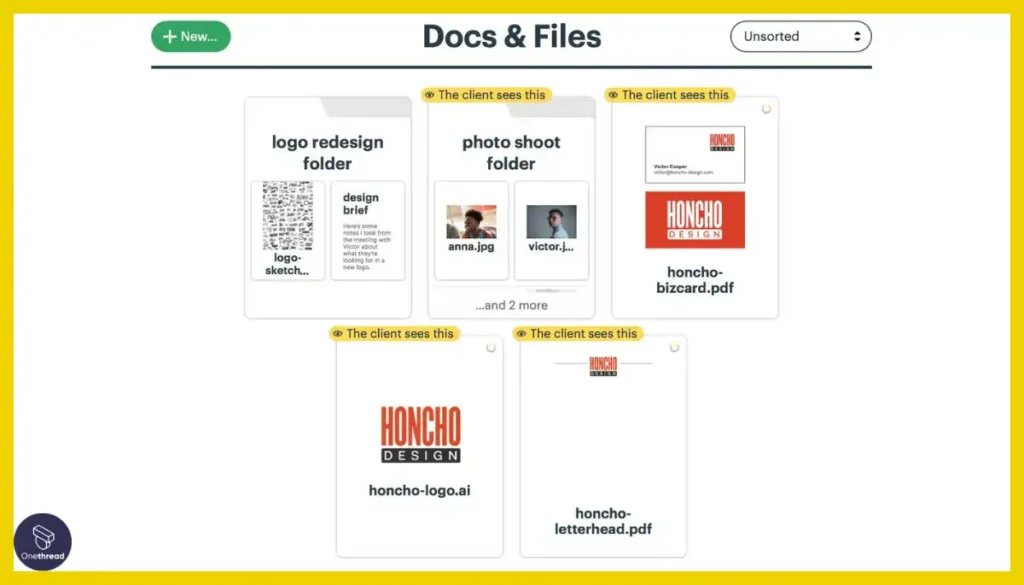
Grants client access to high-level Hill Charts and activity overviews without exposing confidential financial or personal details.
Pros:
- To-do lists simplify task-tracking
- Message Board centralizes discussions
- Easy configuration needs little training
- Automatic Check-Ins gather client feedback
- Affordable starter pricing
Cons:
- Lacks portfolio hierarchy views
- Light on reporting/analytics
- Integration capabilities limited
- Information gaps between tools
Pricing Plans:
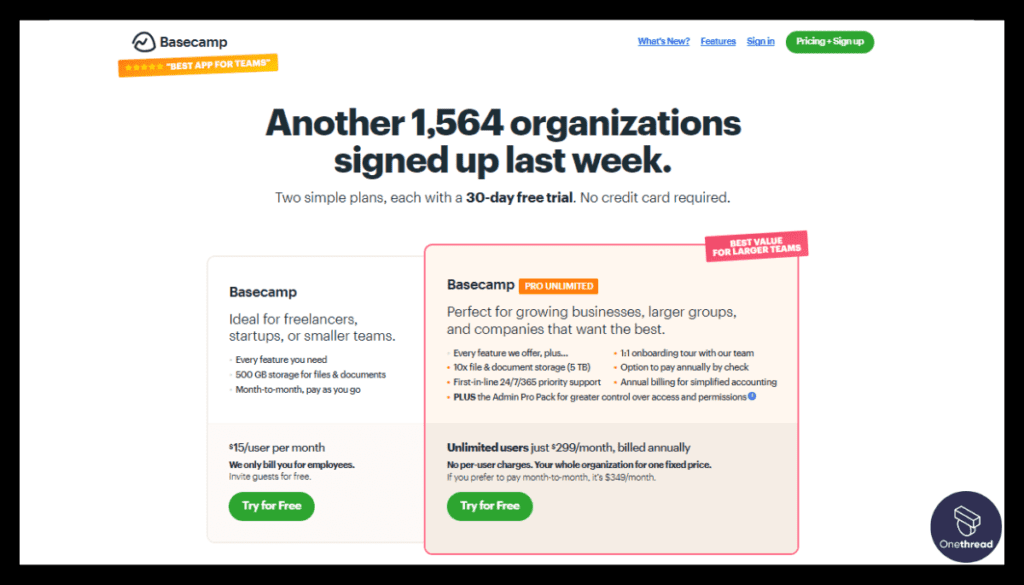
- Basecamp Per User – $15 per user/month (monthly billing)
- Basecamp Pro Unlimited – $299 per month (annual billing), $349 per month (monthly billing)
What Users Say About Basecamp?
Review on G2: 4.1 out of 5
“What do you like best about Basecamp?
Real-time communication is made easy with BaseCamp.
Even beginners can easily use this software for Project management purposes.
What do you dislike about Basecamp?
Sometimes it fails to notify parties of new communications. Not able to download files effectively and some files get lost with the attached task.” – Ashish P.
10. OneDesk
Unified client support and delivery
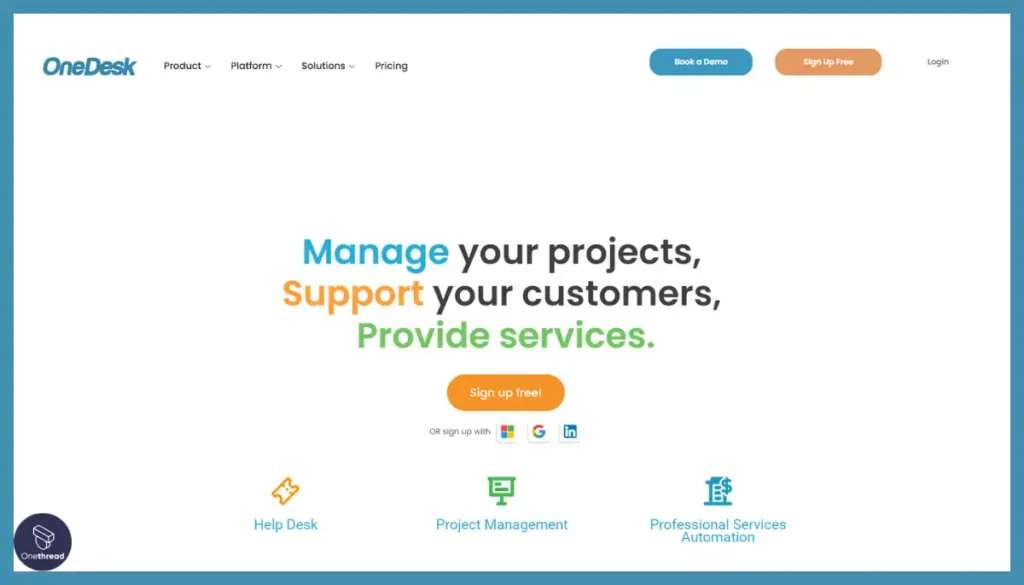
OneDesk partners feature-rich project coordination with equally robust customer support tools for teams delivering professional services and managing external stakeholder interactions. Unifying help desk ticketing and work management avoiding toggling between platforms streamlining context.
Testing revealed OneDesk consolidating the essential conversations around triaging issues, facilitating solutions, and aligning delivery needs between teams and customers. Integrations allow managing work across internal resources while portals serve as a client window avoiding fragmented email chains.
While comprehensive platforms like Agency Handy couple project progress and client dashboards as an equally balanced focus, OneDesk skews slightly heavier toward help desk efficacy based on its legacy strengths. Yet for professional services teams specifically, OneDesk offers more turnkey support management workflows alongside projects.
In the end, OneDesk brings service delivery full circle on supporting and delivering for customers. Consolidating client access as service interactions ebb and flow builds trust and transparency missing when toggling between too many doors and keys.
Features
Explore features that keep your team and clients connected and informed.
Unified Client Portal
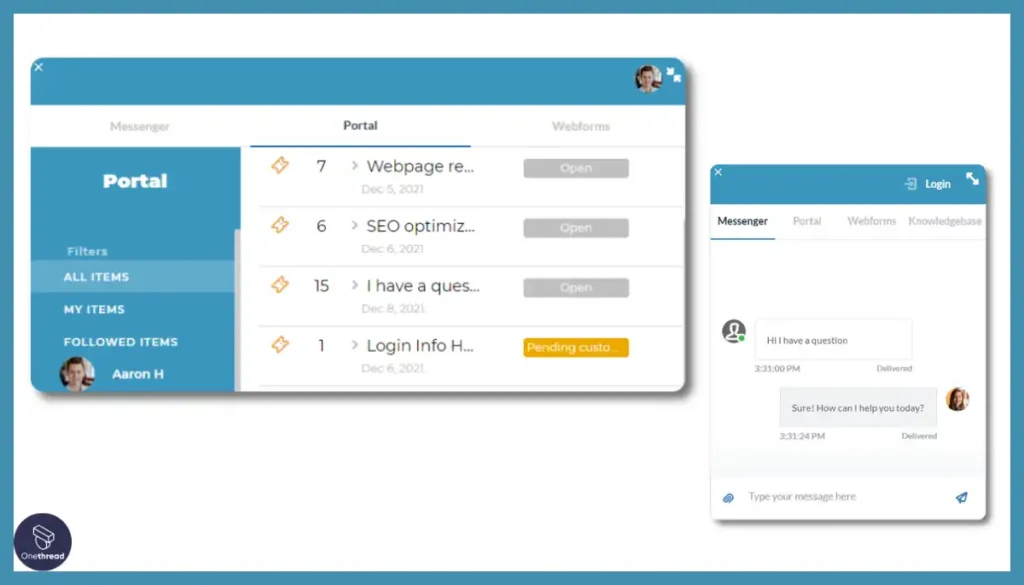
Designates a singular web portal for clients to track tickets, participate in discussions, and access documents related to their projects.
Structured Client Requests
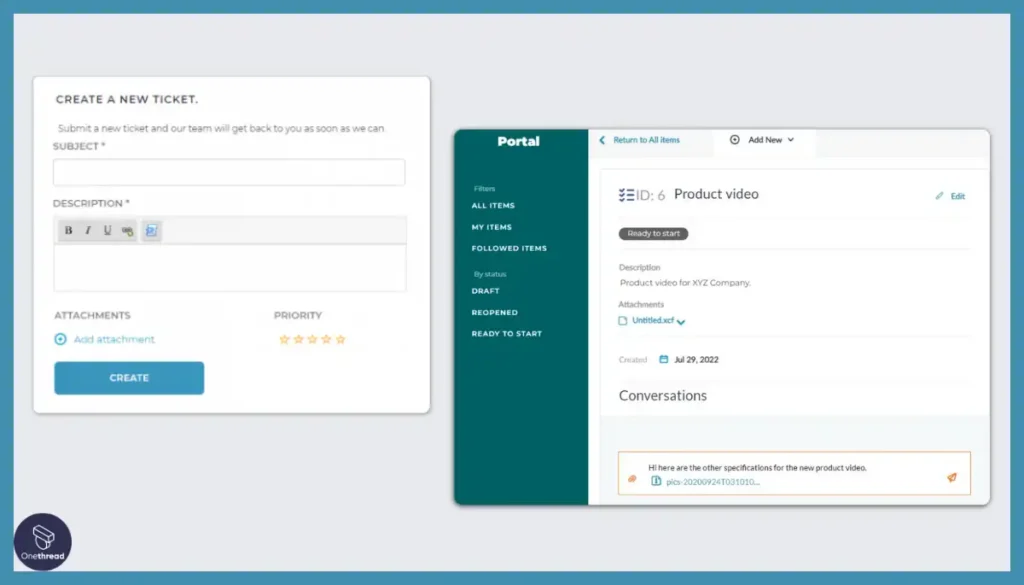
Provides forms for clients to submit help tickets, change orders, and support needs capturing information completely instead of fragmented email inputs.
Custom Access Rules
Configures graduated access rules balancing client collaboration with internal privacy across the portal.
Real-Time Status Updates
Streams task changes, discussions, and uploads relevant to client tickets through a singular feed in the portal to provide transparency.
Automated Notifications
Triggers instant alerts, when ticket milestones are completed or blocking issues, arise to keep clients continually informed.
Pros:
- Unified support ticket and PM tool
- Client portal centralizes interactions
- Custom forms increase structured data
- Task automation increases efficiency
- Affordable packages for all scales
Cons:
- Navigation needs streamlining
- Mobile functionality still developing
- Multiple sign-ons inconvenient
Pricing Plans:
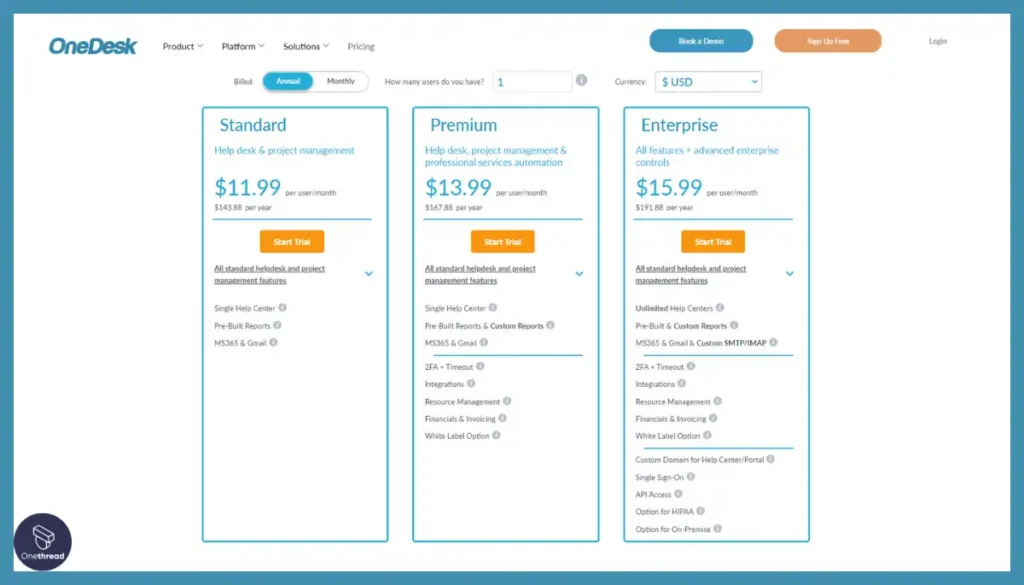
- Standard – $11.99 per user/month (annual billing), $13.99 per user/month (monthly billing)
- Premium – $13.99 per user/month (annual billing), $15.99 per user/month (monthly billing)
- Enterprise – $15.99 per user/month (annual billing), $18.99 per user/month (monthly billing)
What Users Say About OneDesk?
Review on G2: 4.3 out of 5
“What do you like best about OneDesk?
the ease of use and it is also a very complete tool that has options. it can be easily managed by customers by offering them optimal support. I also really like the modern and intuitive interface.
What do you dislike about OneDesk?
Sometimes the platform becomes too slow and I think it is because it has so many options that it does not allow it to function properly. at the same time it would incorporate more useful options for the client.” – Verified User
11. Zoho Projects
Discover how Zoho Projects’ Gantt charts, automation, and unified client profiles empower effective project management for mid-market teams.
Boundless project workflow customization
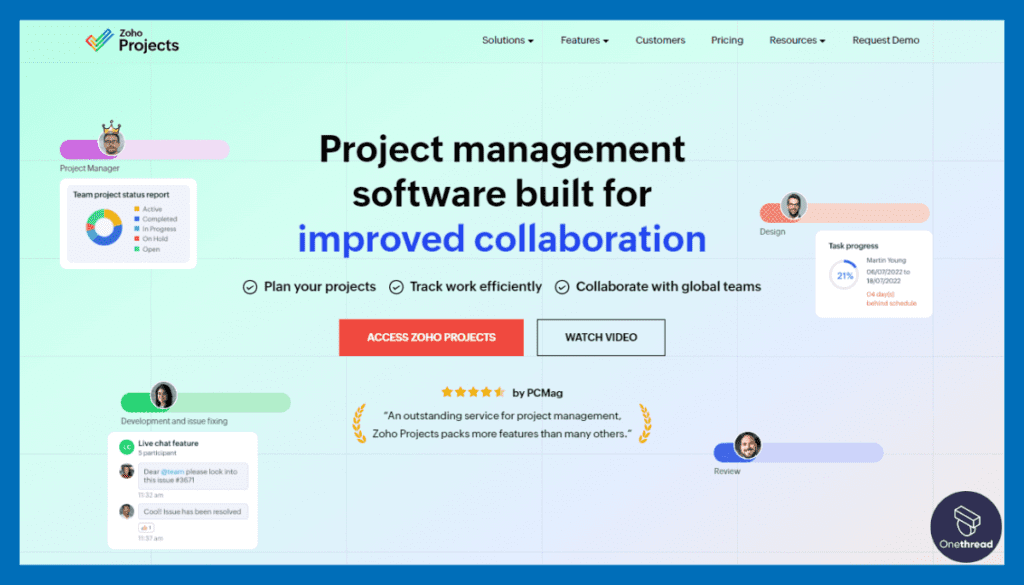
Zoho Projects defines itself as an end-to-end work management platform built for flexibility no matter a team’s project methodology. Testing validated Zoho’s versatility through features accommodating needs from agile to waterfall approaches with the ability to provide some external visibility.
Our analysis revealed Zoho covering core project collaboration essentials from tasks to timesheets to reporting. Where it stretches further is customization and automation capabilities allowing teams to mold workflows to shifting needs, paired with an ecosystem of integrated apps access.
While solutions like Asana champion usability with lightweight versatility, Zoho Projects tilts toward encouraging much deeper platform configuration flexibility and interconnectedness. For more technical users valuing expansive customization over simplicity, Zoho feels like home.
Zoho Projects sustains specialty effectiveness for dev teams who want both project foundations like Asana with wider automation possibilities. For engineering groups viewing PM tools as a launchpad rather than just mission control, Zoho offers more launch pads.
Features
Grant tailored access and insights with Zoho Projects’ unified client profiles and collaboration features.
Unified Client Profiles
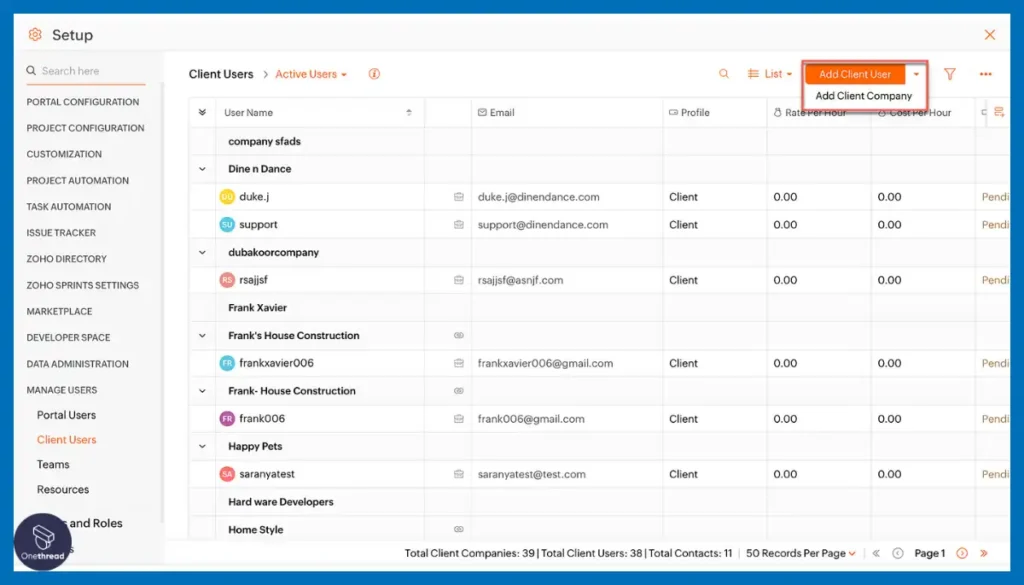
Consolidates contacts, documents, history, and discussions with each client in one dashboard for convenient access to interactions instead of piecing together context.
Selective Data Visibility
Defines graduated access rules on what clients can view or edit in shared projects balancing open collaboration with privacy.
Custom Client Views
Configures specialized Gantt charts, task boards, and calendars filtered for each client’s interests keeping them updated on relevant work.
Structured Client Input
Provides templates for clients to submit requests, queries, and change orders completely instead of vague emails and call summaries.
Automated Client Notifications
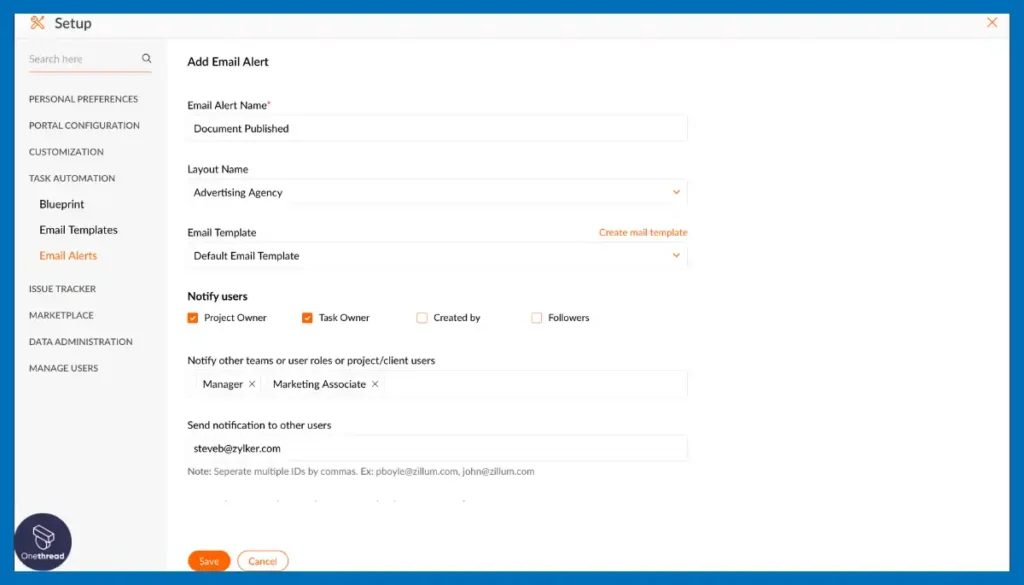
Sets up instant task updates, and milestone achievement alerts that notify clients of important progress without them chasing down changes.
Real-Time Report Dashboards
Streams interactive data visualizations on budget status, workload, and delays for client self-service without manual report generation.
Pros:
- Gantt chart tracks project timelines
- Custom templates accelerate setup
- Automations reduce administrative work
- Affordable pricing with a free tier
- Zia AI provides project insights
Cons:
- Steep learning curve initially
- Fragmented Zoho tool ecosystem
- Task dependency management needs improving
Pricing Plans:
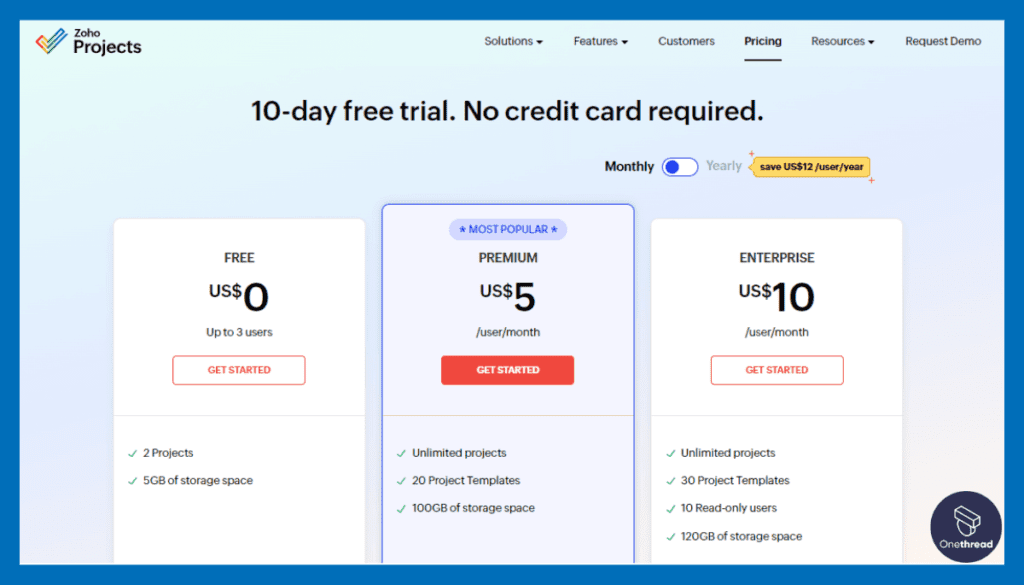
- Free – $0 per user
- Premium – $5 per user/month (annual billing), $6 per user/month (monthly billing)
- Enterprise – $10 per user/month (annual billing), $12 per user/month (monthly billing)
What Users Say About Zoho Projects?
Review on G2: 4.3 out of 5
“What do you like best about Zoho Projects?
There are many customization tools and options for setting up the platform for your needs.
What do you dislike about Zoho Projects?
The platform is not user-intuitive, it constantly has bugs, and there are constant updates to the platform, which make it confusing once you’ve figured an aspect out – they change it.” – Ayami H.
Key Features to Consider in Project Management Software Client Portals
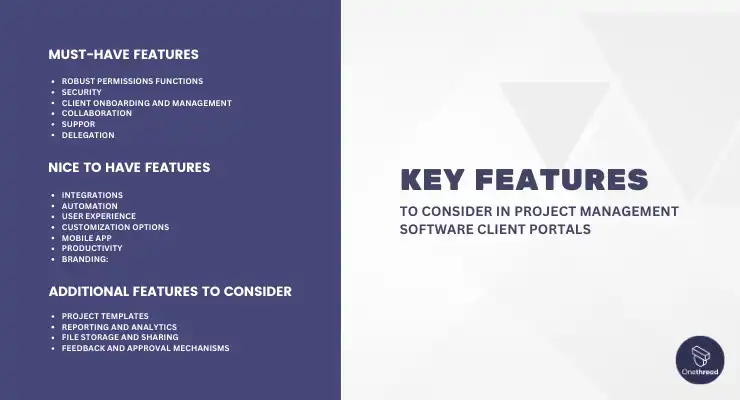
Project success leans on the right project management software. Client portals play a pivotal role. They streamline tasks. They foster communication. When choosing a portal, what features matter? Here are the essential ones.
Must-Have Features:
- Robust permissions functions: Essential for controlling access to sensitive information and ensuring clients only see what they’re authorized to view; advanced controls allow fine-grained access configuration.
- Security: Protects sensitive data with measures like encryption, two-factor authentication, and regular security audits to safeguard confidential information.
- Client onboarding and management: Streamlines client setup, registration, and profile management for a smooth experience that makes it easy to add and manage clients.
- Collaboration: Enables seamless communication, file sharing, and task management between team members and clients to improve transparency.
- Support: Provides a convenient way for clients to seek assistance and resolve issues efficiently through features like help desks and support tickets.
- Delegation: Allows project managers to assign tasks to team members and track progress effectively for streamlined task management.
Nice to Have Features:
- Integrations: Connect with other business tools (email, CRM, accounting, etc.) to streamline workflows and reduce manual data entry through seamless connectivity.
- Automation: Automates repetitive tasks, saving time and reducing errors by setting up pre-defined rules and triggers.
- User experience: Intuitive interface that’s easy for both teams and clients to navigate and use through thoughtful design.
- Customization options: Tailors the software to match specific workflows, branding, and preferences for the right fit.
- Mobile app: Enables access and project management on the go, enhancing flexibility by extending full or selective portal capabilities to mobile.
- Productivity: Features that boost efficiency and task completion, such as time tracking, reporting, and task prioritization to optimize work output.
- Branding: Customize the client portal with your company logo, colors, and branding elements for a cohesive experience that aligns with your brand identity.
Additional Features to Consider:
- Project templates: Pre-built templates for common project types to save time and ensure consistency by standardizing structures and best practices.
- Reporting and analytics: Generate insightful reports on project progress, resource usage, and team performance to inform data-driven decisions and optimization.
- File storage and sharing: Securely store and share project-related files within the client portal to centralize assets and enhance accessibility.
- Feedback and approval mechanisms: Allow clients to provide feedback on deliverables and approve tasks or milestones for greater engagement and oversight.
The right features set projects up for success. Choose wisely. Let your business thrive.
How to Choose The Best Project Management Software With Client Portals?
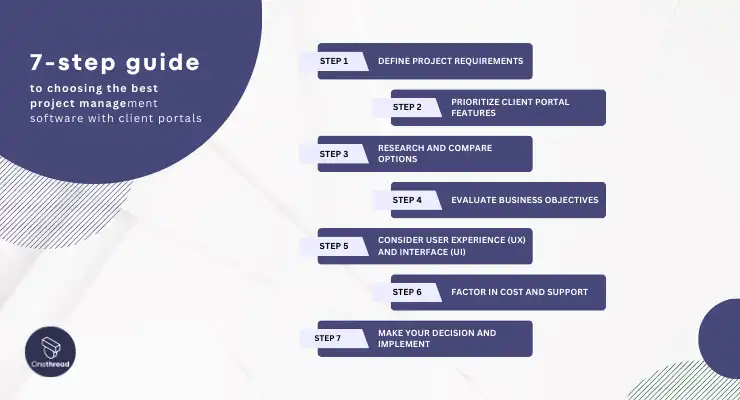
Choosing the right tool can make or break your deal let alone the hazards you’ll be dealing with. So, here is an actionable 7-step guide to choosing the best project management software with client portals:
Step 1: Define Project Requirements
Think about what kinds of projects you will manage, how many team members will use the software and your budget. Outline some typical “must-have” features like task management, collaboration tools, and basic client portal functionality.
Step 2: Prioritize Client Portal Features
These relate to what clients see and can do. Consider collaboration tools for communicating with clients and security settings for controlling access. Highlight important security aspects like access control, data encryption, and compliance considerations for client data.
Step 3: Research and Compare Options
Look at popular software choices and read reviews. See which options have the features you need within your budget. Sign up for demos to try out the software. Explore free trials or limited free plans when comparing options for a hands-on experience.
Step 4: Evaluate Business Objectives
Make sure the software works with other tools you use and can grow with your company. Consider the types of tools you need like email, CRM, or accounting software that align with your business objectives.
Step 5: Consider User Experience (UX) and Interface (UI)
The software should be super easy to use for both your team and clients, with a nice look and feel. Mobile accessibility is also useful.
Step 6: Factor in Cost and Support
Compare pricing models and see what level of customer service is offered. Affordability and responsive support are key. Pay close attention to their subscription models, per-user fees, or any hidden costs beforehand.
Step 7: Make Your Decision and Implement
The final step is deciding on the best-fit option based on your needs, and then rolling it out. Train your team and clients on the software to ensure everyone understands how to use it. Keep gathering feedback to improve the implementation over time.
So, What is The Best Project Management Software with Client Portals?
Agency Handy is the best project management software with client portals because it conveniently combines all the essential features teams need to coordinate work and collaborate with customers in one singular hub.
Beyond robust project planning and execution tools, Agency Handy centralizes client profiles, enables real-time communication, and allows selective data access to provide transparency while protecting sensitive information.
With streamlined customer onboarding, integrated order workflow matching real-world team workflows, and instant progress visibility, Agency Handy removes complexity from managing projects across internal teams and external stakeholders. Users praise the intuitive experience since implementation rarely requires complicated consulting projects like some enterprise alternatives.
While solutions like Onethread and Monday.com also rate highly for their simplicity and smart interfaces, Agency Handy strikes the right balance of ease of use and depth of features necessary for orchestrating initiatives seamlessly across an organization.
For teams that just want one straightforward, affordable system to execute work and keep clients looped in, Agency Handy checks all the boxes.
Getting the Most Out of Project Management Software Client Portals
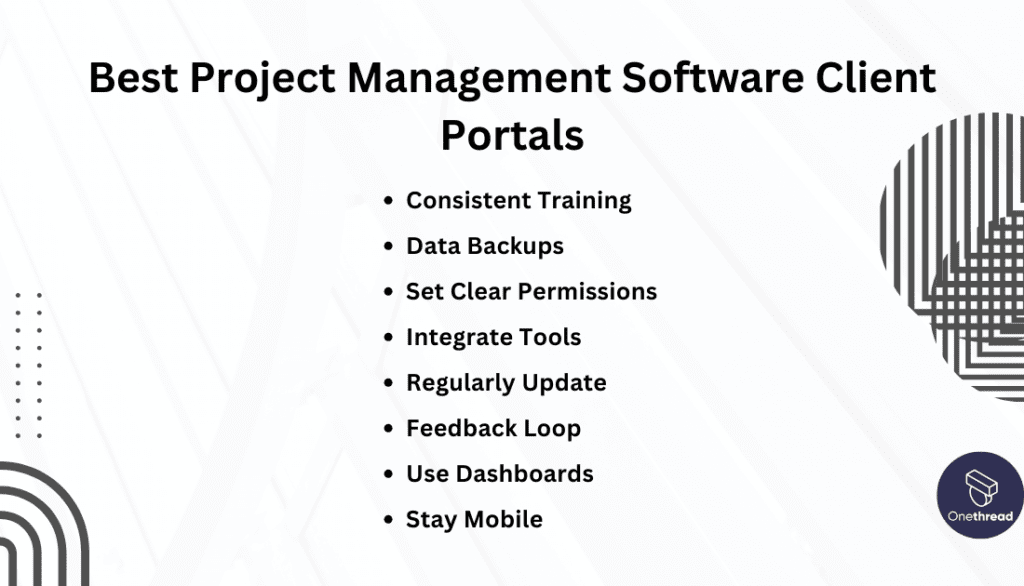
Diving into a client portal can feel daunting. But, with the right approach, it’s a breeze. Harness the full power of your project management software with these best practices.
- Consistent Training: Regularly update teams on new features.
- Data Backups: Safeguard project data regularly.
- Set Clear Permissions: Define roles and access levels.
- Integrate Tools: Combine with other business tools for a seamless workflow.
- Regularly Update: Ensure the software is always current.
- Feedback Loop: Gather team input for continuous improvement.
- Use Dashboards: Gain a quick snapshot of project status.
- Stay Mobile: Use mobile versions for on-the-go management.
With these in hand, your project management endeavors will soar. It’s about being proactive and ever-evolving.
FAQs
Is training required to use these portals?
While many are user-friendly, training can help leverage advanced features and maximize benefits.
How do client portals affect project timelines?
By fostering clear communication and reducing misunderstandings, client portals can streamline processes and potentially speed up project timelines.
Are these portals mobile-friendly?
Most modern project management software offers mobile versions or apps, allowing on-the-go access.
How do client portals benefit the client?
Clients gain a clear view of project progress, can easily communicate feedback, and feel more engaged and valued.
Is there a cost involved in setting up a client portal?
Costs vary. Some software includes it in their package, while others might charge extra. Always check with your provider.
Summary
Project management software client portals are game-changers. They streamline processes, foster collaboration, and enhance efficiency. Selecting the right one is pivotal, leaning on features that resonate with your business needs.
Armed with the perfect portal, project management transforms from a chore to a smooth, automated sail, paving the path for timely and successful project completions. Let your business thrive with the optimal tool in hand.
